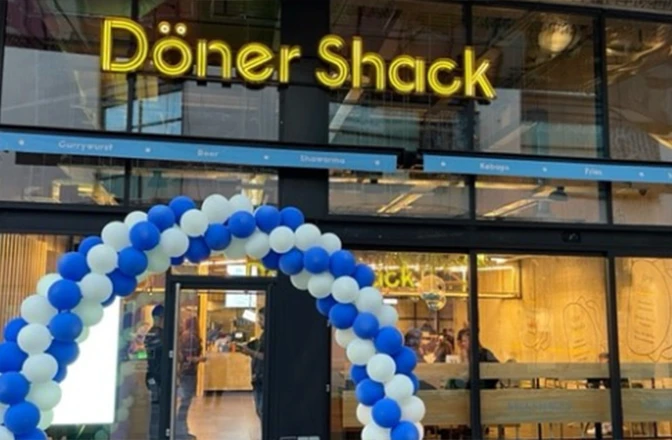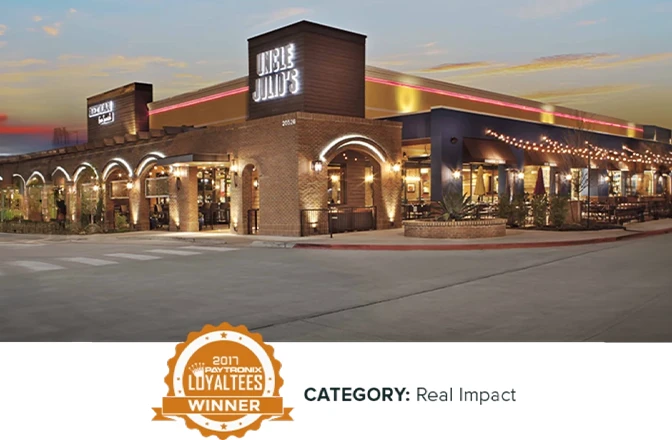Technology is advancing rapidly, transforming industries worldwide. For hospitality businesses, navigating the complex world of Point of Sale (POS) systems is crucial. Modern POS systems are more than just transaction tools; they’re vital for business intelligence. The UK has witnessed the emergence of several innovative POS companies in recent years, such as Zettle, SumUp, NFS hospitality and Lightspeed. Upgrading or investing in a new POS system can enhance operational efficiency, boost customer service, streamline inventory management, and improve financial reporting. Let’s explore how to turn this decision into a chance for transformative growth.
We’ve crafted this handy checklist to help you choose the perfect POS system for your business. With this guide in hand, you can confidently tackle the complexities of selecting a POS, making sure your choice meets today’s needs and sets you up for future success. Let’s explore the key features and considerations that will help your hospitality business flourish.
Essential Point of Sale System Checklist for Hospitality Businesses
- Full Cost Considerations: Assess all associated costs, including upfront, rental, and ongoing fees.
- Integrations:
- Reservation Systems: Ensure compatibility with booking and reservation platforms.
- Inventory Management: Look for seamless integration with inventory tracking systems.
- Third-Party Delivery Apps: Check for easy connectivity with popular delivery services.
- Customization: Evaluate the system’s ability to be tailored to your specific business needs.
- User-Friendly Interface Importance: Prioritise systems with intuitive interfaces to reduce training time and improve staff efficiency.
- Streamlining Payment Processes: Ensure the system supports efficient and varied payment methods to enhance customer experience.
- Ensuring Data Privacy Compliance: Verify that the system complies with data protection regulations to safeguard customer information.
- Training Support: Look for comprehensive training resources and support to facilitate smooth onboarding.
- Cloud-Based vs. On-Premise Systems: Decide between cloud-based solutions for flexibility and remote access, or on-premise systems for greater control and security.
By considering these elements, you can choose a POS system that not only meets your current needs but also supports your business’s long-term success.
Full Cost Considerations
When selecting a Point of Sale system, it’s essential to consider the entire financial landscape. Look beyond upfront or rental fees to include SaaS subscriptions for ongoing updates and support, ensuring your system stays cutting-edge. Additionally, factor in card processing fees, as they impact your bottom line with each transaction. By evaluating these costs together, you can create a realistic financial forecast that aligns with your business goals, safeguarding your investment’s long-term value and supporting sustainable growth in the dynamic hospitality industry.
Here are some key financial considerations to keep in mind when selecting a Point of Sale system:
- Upfront Costs: Evaluate the initial purchase price or setup fees for the POS hardware and software.
- Rental Fees: Consider any ongoing rental charges if you opt for leasing the equipment instead of purchasing it outright.
- SaaS Subscriptions: Account for monthly or annual fees for software updates, support, and additional features that keep your system current.
- Integration Fees: Check for costs associated with integrating the POS system with existing software or third-party applications.
- Card Processing Fees: Understand the transaction fees charged by payment processors, as these can significantly affect your profit margins.
- Maintenance and Support Costs: Factor in any expenses related to technical support, repairs, or maintenance services.
Software Compatibility and Integration
Ensuring the compatibility of your POS system with existing software is paramount to creating a seamless experience across sales, inventory, and data management, thereby enhancing the overall efficiency of your hospitality establishment.
Taking advantage of integration capabilities allows different systems within your business to communicate and exchange data seamlessly. Most POS systems clearly display their integration capabilities within their tech stack, allowing you to easily determine how well they will fit into your current setup.
Reservation Systems
Streamlined bookings elevate service delivery and boost customer satisfaction significantly.
Incorporating seamless connectivity with a Point of Sale system, it facilitates a “one-stop solution.” This is not only a mark of convenience but enables a more personal touch, tailoring services to each guest’s preferences.
Commitment to investing in robust reservation systems can revolutionise the way you handle guest interactions. By integrating automated features such as real-time calendar updates and direct communication links, you ensure every aspect of your customer journey is meticulously curated, reinforcing your establishment’s reputation for excellence.
Inventory Management
Effective inventory management is pivotal for reducing waste and optimising supply chain efficiency in the hospitality industry.
- Real-time Tracking: Implement a system that offers real-time updates on stock levels to avoid shortages or overstocking.
- Integration: Ensure seamless integration of the POS system with your inventory management software for synchronised data.
- Automated Reordering: Automate reordering processes to maintain optimal stock levels without manual intervention.
- Reporting and Analytics: Leverage robust analytics tools to gain insights into consumption patterns and adjust orders accordingly.
- Vendor Management: Manage supplier information effectively to facilitate timely order placements and deliveries.
A sophisticated point of sale system checklist should prioritise these inventory features for maximised operational efficiency.
Harnessing comprehensive inventory management tools can substantially enhance profitability and streamline back-of-house operations.
Third-Party Delivery Apps
In the fast-paced hospitality sector, integrating third-party delivery apps with your POS system can be transformative. For many venues, delivery services can account for a significant portion of their revenue, sometimes reaching as high as 30% or more. This underscores the importance of seamless integration, ensuring that orders are efficiently processed and managed.
Efficient app integration can enhance customer satisfaction while expanding your restaurant’s reach with minimal hassle.
Customization
In the dynamic world of hospitality, every establishment has its unique identity, aspirations, and customer base. A tailored approach to your point of sale system checklist can significantly amplify your brand’s distinctiveness.
Customisable features allow you to adapt the POS system’s appearance and functions to your specific business needs. This personal touch enhances operational efficiency.
Every element, including interface customisation and tailored reporting, underscores (and optimises) your brand’s value proposition.
Custom fields help in capturing necessary customer information for personalised service, propelling your guest experience forward.
When your POS resonates with your brand ethos, it communicates a commitment to excellence, offering value across interactions. Your capacity for innovation and leadership becomes apparent.
Indeed, there is no limit to where one’s idea of ‘customisation’ could lead. Confidently harnessing bespoke POS solutions could catalyse your voyage toward business success.
User-Friendly Interface Importance
Having a user-friendly interface is crucial for efficiency and ease of operations within any hospitality environment, and this area holds immense potential for growth.
Employees and guests both benefit when systems require minimal training.
Interface simplicity can significantly reduce onboarding time, ensuring staff spend more time on customer-facing duties rather than grappling with technology. Designing intuitive systems enhances productivity, promotes satisfaction, and fosters a positivity that resonates through the establishment.
For hospitality businesses seeking to stay ahead of the curve, a focus on the user experience can not only streamline operations but elevate guest interactions to consistently surpass expectations. As technology evolves, embracing the ‘ease of use’ as a benchmark can differentiate your service offering, ultimately winning the loyalty and trust of both staff and patrons.
Streamlining Payment Processes
Streamlining payment processes is paramount for hospitality businesses. By prioritising efficiency, a robust point of sale system checklist can set you on a trajectory towards seamless transactions.
Immediate authorisation speeds up customer service, enhancing satisfaction. Swift, error-free transactions are critical in hospitality’s fast-paced environment.
Additionally, adopting contactless options will further improve customer experience. The flexibility to accommodate diverse payment methods is now essential.
Integrated payment solutions also enhance operational effectiveness by reducing bottlenecks. Accessible transaction data allows for smarter business decisions.
Offering varied payment gateways accommodates modern consumer needs, reflecting progressive hospitality operations. Thus, optimising payment processes can drastically elevate customer interactions, brand credibility, and foster loyalty.
Ultimately, the art lies in how well your system marries efficiency with security. Elevating client experience means selecting technological advancements that both protect and serve.
Ensuring Data Privacy Compliance
In today’s digital age, data privacy is not just a priority but a legal obligation across many industries, particularly in hospitality.
When considering a point of sale system checklist for a hospitality business, ensuring data privacy compliance requires rigorous assessment of system security features. Your system should support encryption for cardholder information and personal data, alongside advanced threat detection to mitigate risks. Implementing these elements is vital to ensuring customer trust and safeguarding your establishment’s reputation.
Moreover, compliance with regulations such as GDPR is crucial. This entails knowing exactly how your customers’ data is handled, stored, and shared. It requires a system robust enough to offer top-tier data protection while allowing seamless operational functionality.
By prioritising data privacy compliance within your point of sale system, you not only adhere to necessary legal standards, but also demonstrate a steadfast commitment to your patrons’ security. This proactive stance will bolster customer confidence, attract more discerning clientele, and ultimately position your business as a leader in both service excellence and ethical responsibility.
Training Support
The success of any POS system hinges on quality staff training. A well-structured program tailored to your hospitality business ensures staff are confident and efficient from the start. Look for POS providers that offer comprehensive training and access to a resource library with online tutorials, FAQs, and live chat support. This ongoing support empowers your team to handle system challenges, fostering continuous learning and ensuring seamless service delivery. Ultimately, robust training enhances operational efficiency and upholds your establishment’s reputation for excellent customer service and innovation.
Future-Proofing Your POS System
Future-proofing your POS system is essential for adapting to the evolving hospitality industry. Choose a system with cloud capabilities for seamless updates and an open API for easy integration of third-party apps and new functionalities. Ensure it supports scalability to accommodate growth and new revenue streams without sacrificing efficiency. By selecting a POS that anticipates future trends, you secure long-term agility and success.
Cloud-Based vs. On-Premise Systems
The decision between a cloud-based and on-premise system hinges on the unique nuances of your hospitality business, financial landscape, and vision for growth. As you navigate this critical choice, a comprehensive understanding of each option will empower you to align technological implementation with strategic objectives.
Cloud-based POS systems offer the distinct advantage of anytime, anywhere access. This is invaluable for dynamic industries like hospitality where responsiveness is paramount.
Conversely, on-premise solutions provide greater control over data and functionality, which some organisations may prefer for top-tier privacy.
Furthermore, the cost structure of cloud systems typically involves a subscription model, offering scalable payments. This flexibility can be attractive for businesses aiming to manage costs effectively.
It remains vital to meticulously evaluate your operational needs against these options, acknowledging staff capabilities. Recognising the inherent advantages and limitations can ensure your POS system enhances productivity.
Ultimately, the best decision reflects your business’s ethos and future outlook. It’s about an innovative solution aligning with long-term objectives while maximising efficiency and guest satisfaction.
Conclusion
Your POS system is crucial. The right point of sale system checklist can transform operations and enhance customer experiences. Evaluate features tailored to your goals for quality service.
As technology evolves, choose a POS that aligns with your vision to streamline operations and boost competitiveness. NFS Hospitality offers hospitality tech solutions to support your growth and ensure sustained success, request a demo now to find out more.
The festive season is here, and Christmas Day is the pinnacle of celebrations for diners seeking memorable culinary experiences.
As a restaurant owner or chef, this is your moment to shine, crafting a menu that not only captures the spirit of the holiday but leaves your guests raving long after the decorations come down.
From traditional classics with a twist to modern, innovative creations, the possibilities are endless. Creating a Christmas menu that balances tradition with tantalising innovation is your winning formula to impress and delight guests.
Why do sessional changes or a Christmas day menu at all?
Introducing sessional changes into your Christmas planning brings fresh excitement and a delightful surprise to each festive season.
As each season unfolds, incorporating changes into a Christmas menu keeps the experience vibrant, catering to the evolving tastes of guests and inspiring curiosity.
These changes, however subtle, can rejuvenate traditional dishes and excite adventurous palates, turning a mere meal into a memorable celebration marked by culinary artistry.
Traditionally, festive celebrations adhered strictly to classic recipes. By making sessional changes, you can breathe new life into time-honoured flavours while respecting cherished customs.
Leveraging the festive period can significantly boost engagement and attendance at your Christmas events, as well as enhance sales for businesses. Check out these figures that illustrate the potential impact:
- Increased Consumer Spending: During the festive season, consumer spending typically rises by 20-30% compared to other times of the year. This increase is driven by holiday shopping, dining, and entertainment, providing a prime opportunity to attract more guests to your Christmas events or restaurant.
- Higher Attendance Rates: Events held during the festive period often see a 15-25% increase in attendance. The holiday spirit encourages people to gather and celebrate, making it an ideal time to host memorable gatherings that draw larger crowds.
- Boost in Food and Beverage Sales: Restaurants and catering services can experience a 30-50% increase in sales during the Christmas season. Special festive menus and themed events entice customers to indulge in unique culinary experiences.
Exploring Timeless Starters with a Twist
Kick off your restaurant’s Christmas menu with these enticing appetizers, each offering a delightful twist on classic flavours to set the stage for a memorable dining experience:
- Smoked Salmon and Dill Blinis: Delicate smoked salmon served atop fluffy blinis, garnished with a dollop of crème fraîche and fresh dill. Add a twist with a hint of lemon zest for a refreshing burst of flavour.
- Roasted Beetroot and Goat Cheese Salad: A vibrant salad featuring roasted beetroot, creamy goat cheese, and candied walnuts, drizzled with a balsamic glaze. Introduce a twist by adding a sprinkle of pomegranate seeds for a touch of festive colour and sweetness.
- Chestnut and Mushroom Soup: A rich and creamy soup made with roasted chestnuts and earthy mushrooms, finished with a drizzle of truffle oil. Serve with a twist of crispy sage leaves for an aromatic garnish.
- Duck Liver Pâté with Spiced Pear Chutney: Silky duck liver pâté paired with a sweet and spiced pear chutney, served with toasted brioche. Add a twist by incorporating a hint of star anise in the chutney for a warm, festive note.
- Crab and Avocado Timbale: Layers of fresh crab meat and creamy avocado, seasoned with lime and coriander, and topped with microgreens. For a twist, add a touch of chilli for a subtle kick.
- Caramelised Onion and Blue Cheese Tartlets: Mini tartlets filled with sweet caramelised onions and tangy blue cheese, baked to golden perfection. Introduce a twist by adding a sprinkle of toasted pine nuts for added texture.
- Spiced Pumpkin and Lentil Fritters: Crispy fritters made with spiced pumpkin and lentils, served with a cooling mint yoghurt dip. Add a twist by incorporating a hint of cumin and coriander for a fragrant aroma.
- Roasted Red Pepper and Tomato Bruschetta: Grilled slices of crusty bread topped with a vibrant mixture of roasted red peppers, cherry tomatoes, and fresh basil. Drizzle with balsamic reduction for a burst of flavour. Add a twist by incorporating a sprinkle of toasted sunflower seeds for a delightful crunch.
These starters offer a delightful blend of tradition and innovation, ensuring your Christmas menu captivates and excites your diners from the very first bite.
Showcasing Seasonal Main Courses That Shine
For a Christmas menu, it’s essential to offer main courses that capture the festive spirit while showcasing culinary excellence. Here are some exceptional options that seamlessly blend tradition with innovation, guaranteeing a dining experience that will be truly unforgettable:
- Herb-Crusted Prime Rib: A succulent prime rib roast seasoned with a blend of fresh herbs and garlic, served with a rich red wine jus. This classic dish offers a luxurious and hearty option for meat lovers.
- Stuffed Turkey Breast Roulade: A modern take on the traditional roast turkey, featuring a rolled turkey breast filled with a savoury stuffing of cranberries, chestnuts, and herbs. This dish is both elegant and flavourful, perfect for a festive occasion.
- Pan-Seared Duck Breast with Cherry Glaze: Tender duck breast cooked to perfection and drizzled with a sweet and tangy cherry glaze. Serve with a side of roasted root vegetables for a dish that balances richness with seasonal flavours.
- Wild Mushroom and Truffle Risotto: A creamy risotto infused with the earthy flavours of wild mushrooms and finished with a hint of truffle oil. This vegetarian option is both indulgent and satisfying, appealing to a wide range of diners.
- Braised Lamb Shanks with Rosemary and Red Wine: Slow-cooked lamb shanks that are fall-off-the-bone tender, served with a fragrant rosemary and red wine sauce. Pair with creamy mashed potatoes for a comforting and robust main course.
- Baked Salmon en Croûte: Fresh salmon fillet wrapped in puff pastry with a layer of spinach and cream cheese, baked to golden perfection. This dish offers a sophisticated seafood option that is both visually impressive and delicious.
- Butternut Squash and Sage Ravioli: Handmade ravioli filled with roasted butternut squash and sage, served in a brown butter sauce with toasted pine nuts. This vegetarian dish is a celebration of seasonal ingredients and rich flavours.
- Stuffed Acorn Squash with Quinoa and Cranberries: Roasted acorn squash halves filled with a vibrant mixture of quinoa, dried cranberries, toasted pecans, and aromatic herbs. This dish is not only visually stunning but also offers a delightful combination of textures and flavours, making it a perfect centrepiece for a festive vegan meal.
These main courses are designed to shine at any Christmas event, offering a diverse array of flavours and presentations that will delight your diners and create a festive atmosphere.
Crafting Festive Cocktails with Flair
Cheers to festive creativity with themed cocktails. Themed cocktails provide a wonderful opportunity to elevate the mood of your Christmas gathering. They bring a touch of whimsy and sophistication to your Christmas menu, drawing on flavours that evoke the season.
Think of them as the perfect conversation starter or festive icebreaker, warming the hearts and spirits of your guests. Traditional ingredients can serve as an exciting launching pad.
Transform classic cocktail recipes by incorporating unique seasonal ingredients like pomegranate, rosemary, or cinnamon. These not only breathe new life into old favourites but also amplify your guests’ sensory delight, lifting your Christmas celebration to unforgettable heights.
- Spiced Pomegranate Martini: Shake up the classic martini with pomegranate juice, a splash of orange liqueur, and a hint of cinnamon. Garnish with a sugared rim and a sprig of rosemary for a festive flair.
- Cranberry Mint Fizz: Create a refreshing mocktail by combining cranberry juice, sparkling water, and a dash of lime. Add fresh mint leaves and a few cranberries for garnish to make it sparkle with holiday cheer.
- Gingerbread Old Fashioned: Infuse bourbon with gingerbread spices, then mix with a touch of maple syrup and a dash of bitters. Serve over ice with a cinnamon stick stirrer and an orange twist for a warm, nostalgic twist.
- Mulled Wine Sangria: Blend traditional mulled wine spices with red wine, brandy, and a mix of seasonal fruits like apples and oranges. Serve chilled with a cinnamon stick for a delightful fusion of two holiday classics.
Non-Alcoholic Alternatives
Elevate your Christmas celebration with these delightful non-alcoholic cocktails alternatives, ensuring every guest can enjoy the festive cheer:
- Cranberry Mint Fizz: A refreshing blend of cranberry juice, sparkling water, and a dash of lime, garnished with fresh mint leaves and cranberries for a sparkling holiday touch.
- Cinnamon Apple Spritzer: A crisp mix of apple cider and ginger ale with a dash of cinnamon, served over ice with a cinnamon stick and apple slice for a festive refreshment.
- Pomegranate Rosemary Cooler: Pomegranate juice combined with lemon infused sparkling water and a hint of lemon, garnished with a sprig of rosemary and pomegranate seeds for a vibrant, aromatic drink.
- Winter Berry Punch: A colourful blend of berry juices with a splash of orange juice, topped with soda water and adorned with fresh berries and an orange peel twist.
- Spiced Citrus Sparkler: A zesty combination of orange and grapefruit juices with a hint of ginger and a splash of soda water, garnished with a slice of citrus and a star anise for a festive flair.
- Vanilla Chai Latte Mocktail: A warm blend of chai tea and steamed milk with a touch of vanilla syrup, topped with whipped cream and a sprinkle of nutmeg for a cozy, indulgent treat.
- Peppermint Hot Chocolate: A rich hot chocolate infused with peppermint syrup, topped with whipped cream and crushed candy canes for a classic holiday delight.
These non-alcoholic cocktails offer a delightful array of flavours and aromas, ensuring that every guest can partake in the festive spirit and enjoy a memorable Christmas celebration.
Delectable Desserts to Sweeten the Occasion
Elevate the grand finale of your Christmas feast with these enchanting desserts, each designed to capture hearts and linger on taste buds:
- Yule Log (Bûche de Noël): A classic French dessert that embodies the spirit of Christmas. This rolled sponge cake, filled with rich chocolate ganache and decorated to resemble a log, is both visually stunning and deliciously indulgent.
- Gingerbread Trifle: Layer spiced gingerbread cake with creamy custard, whipped cream, and a hint of caramel sauce. Top with gingerbread cookies for a festive twist on a traditional trifle.
- Eggnog Cheesecake: A creamy cheesecake infused with the flavours of eggnog, nutmeg, and vanilla, set atop a spiced biscuit crust. Garnish with a sprinkle of cinnamon and a dollop of whipped cream for a decadent treat.
- Cranberry and Orange Pavlova: A crisp meringue base topped with a tangy cranberry compote and fresh orange slices, finished with a cloud of whipped cream. This dessert offers a refreshing balance of sweet and tart.
- Spiced Pear Tart: A buttery pastry crust filled with poached pears and a spiced almond cream, baked to perfection. Serve warm with a scoop of vanilla ice cream for a comforting end to the meal.
- Chocolate and Chestnut Roulade: A rich chocolate sponge rolled with a chestnut cream filling, dusted with cocoa powder and adorned with chocolate shavings. This dessert is a luxurious nod to traditional Christmas flavours.
- Mulled Wine Poached Pears: Pears gently poached in a spiced mulled wine reduction, served with a drizzle of the syrup and a scoop of vanilla ice cream. This dessert is both elegant and aromatic, capturing the essence of the season.
These Christmas-themed desserts not only dazzle in flavour but also in presentation, ensuring that the last notes of your festive dining experience are a delightful crescendo of indulgence and joy.
Interactive Experiences
Transform dining into a multi-sensory adventure by integrating interactive elements into your Christmas menu. QR code table-side ordering offers a seamless and engaging experience, allowing guests to effortlessly browse the menu, customise orders, and explore options like garnishing their own festive cocktails or building dessert combinations—all from their smartphones. This technology streamlines the ordering process, reducing wait times and enhancing enjoyment.
The concepts of “taste-tainment” and “dine-n-play” are elevated with QR code ordering, empowering guests to actively participate in their culinary journey. This modern approach ensures your Christmas celebration is both memorable and efficient, leaving guests delighted and eager to return for more festive magic.
Conclusion
As Christmas Day approaches, your menu has the power to create lasting memories for your diners. By blending festive traditions with creative twists, catering to diverse tastes, and ensuring every detail—from appetisers to desserts—is thoughtfully crafted, you can deliver a dining experience that stands out.
Whether it’s the comfort of familiar holiday classics or the thrill of discovering something new, your carefully curated menu can capture the magic of the season.
Ultimately, the heart of Christmas lies in these shared moments, where nourishment becomes a celebration of our bonds. So, embrace the opportunity to wow your diners, and let your Christmas Day offerings be the highlight of their holiday celebrations.
If you’re looking to take your hospitality to the next level, NFS Hospitality offers innovative cloud POS solutions to streamline operations and elevate your dining experiences. From advanced reservation systems to tools that enhance customer satisfaction, our technology can help make your festive season seamless and successful.
Contact NFS Hospitality today to learn how we can support your Christmas Day preparations and beyond. Together, let’s create a season to remember.
The choice of a Point of Sale (POS) system can significantly impact the operational efficiency, customer experience, and ultimately, the success of a business. POS systems, serving as the hub of sales, inventory management, and customer management, have evolved from mere cash registers to sophisticated platforms that offer many features to support businesses in their daily operations. You need to get the right software as on-premise or cloud based pos systems for retail are not designed for restaurants – you need to get something tailored.
At the heart of this evolution is a critical decision that businesses, regardless of size and industry, find themselves grappling with: should they opt for a cloud-based POS system that boasts flexibility and real-time access, or a traditional on-premise solution known for its reliability and control? The answer is not straightforward, as each option comes with its unique set of advantages and challenges.
It is essential to keep in mind that the right choice varies from one business to another, depending on various factors such as the nature of the business, budget constraints, and specific operational requirements.
With this guide we want you to be able to choose the best EPOS system for restaurants for your business.
Overview of Cloud-based POS systems
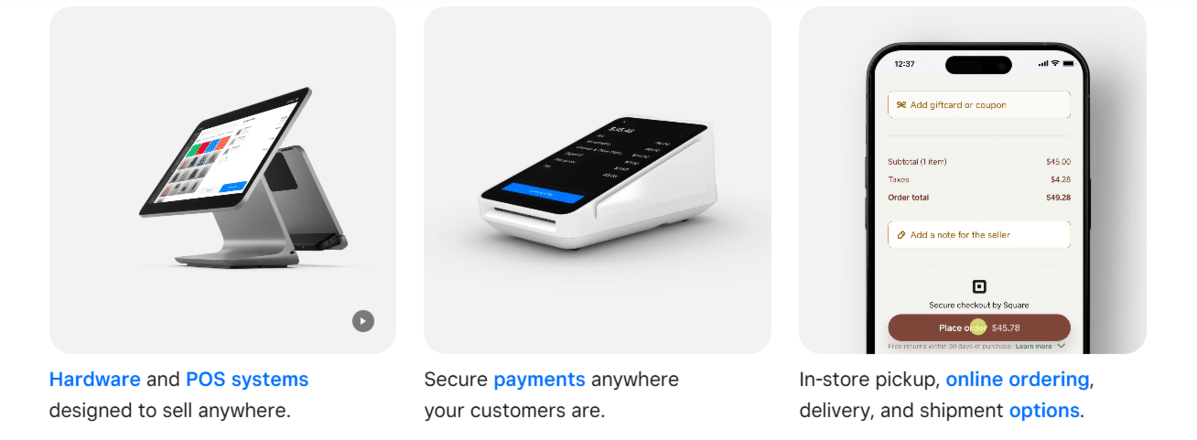
Cloud-based POS systems represent a modern approach to managing sales and operations, harnessing the power of the internet to offer businesses a flexible and scalable solution. Unlike traditional systems, a cloud POS operates on a software-as-a-service (SaaS) model, where the software is hosted on remote servers and accessed via the web or an app. This model offers several distinct advantages and some drawbacks that businesses need to consider.
Key features and benefits:
Accessibility: one of the hallmark features of cloud-based POS systems is their accessibility. Business owners and managers can access sales data, inventory levels, and customer information in real-time from anywhere in the world, provided they have an internet connection. This level of accessibility supports informed decision-making and allows for greater flexibility in managing operations remotely.
Scalability: as businesses grow, their needs change. Cloud POS systems are inherently scalable, allowing businesses to add more registers, locations, or features with minimal hassle. This adaptability ensures that the POS system can grow alongside the business, without the need for significant overhauls or investments.
Cost-effectiveness: initially, cloud-based systems may appear more budget-friendly, especially for small to medium-sized businesses, due to their subscription-based pricing models. There’s no need for substantial upfront investments in hardware or software licenses. Instead, businesses pay a monthly or annual fee that often includes updates, maintenance, and technical support, reducing the total cost of ownership.
Potential drawbacks:
Dependency on internet connection: The primary limitation of cloud-based POS systems is their reliance on a stable and fast internet connection. Should the internet go down, accessing the POS system or processing transactions can become challenging, potentially disrupting business operations.
Ongoing costs: while the initial costs are lower, the subscription fees can add up over time, making it more expensive in the long run. Businesses need to carefully consider their long-term costs when opting for a cloud-based system.
Data security concerns: storing sensitive business and customer data on remote servers brings about concerns regarding data security and privacy. Reputable cloud POS providers invest heavily in security measures, but businesses should conduct thorough research to ensure their data will be protected against breaches.
Overview of On-premise POS systems
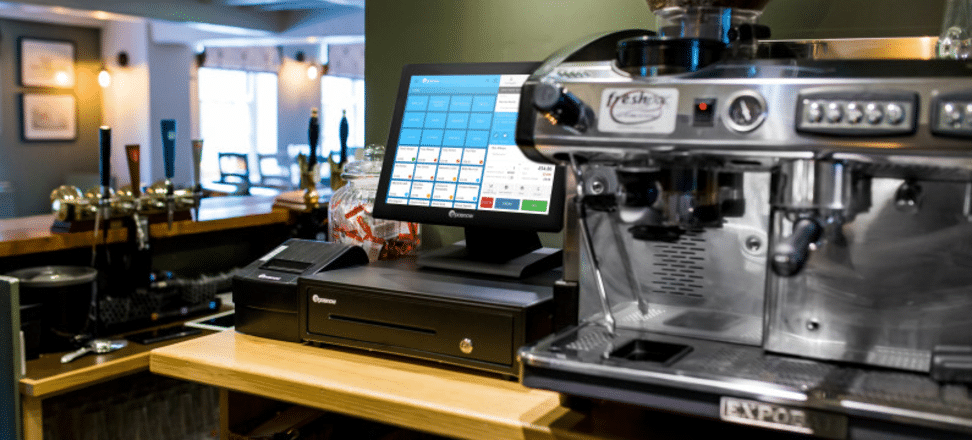
On-premise POS systems are the traditional choice for many businesses, offering a more conventional approach to sales and inventory management. Unlike their cloud-based counterparts, on-premise solutions are installed locally on a business’s servers and run on its network. This setup provides businesses with full control over their POS system and data, but it also comes with its set of challenges and considerations.
Key features and benefits:
Control and ownership: the most significant advantage of on-premise POS systems is the level of control and ownership they offer. Businesses have complete autonomy over their system, including customisation, data management, and security protocols. This control is particularly appealing for businesses with highly specific needs or those operating in industries with stringent data protection regulations.
Offline functionality: on-premise systems do not rely on an internet connection to operate. Transactions and operations can continue seamlessly, even during internet outages, making them reliable in environments where connectivity is inconsistent or unreliable.
One-time investment: although the initial cost of an on-premise POS system can be high—due to hardware purchases, software licenses, and setup fees—it’s a one-time investment. Over time, this can be more cost-effective than recurring subscription fees associated with cloud-based solutions, especially for larger businesses with the capital to invest upfront.
Limitations:
High upfront costs: the initial investment for on-premise POS systems is significant, making it a less viable option for small businesses or startups with limited budgets. The cost includes not only the software and hardware but also maintenance and potential upgrades.
Maintenance and updates: businesses are responsible for maintaining their on-premise systems, including hardware repairs and software updates. This responsibility requires in-house IT expertise or external support contracts, adding to the operational costs.
Scalability issues: scaling an on-premise POS system can be more complex and costly than a cloud-based solution. Expanding the system to accommodate business growth often requires additional hardware purchases and software licensing fees, as well as potential downtime during the upgrade process.
Comparative analysis
When choosing between a cloud based POS system and on-premise POS systems, businesses must weigh various factors to determine which solution aligns best with their operational requirements, budget, and long-term goals. This comparative analysis delves into the performance, security, and cost implications of each system, offering insights to help make an informed decision.
Cloud based POS systems are ideal for businesses that operate in multiple locations or require remote access to their sales and inventory data. The flexibility and real-time data synchronization make it easier to manage operations on the go. However, performance for cloud based pos systems heavily depends on internet connectivity, which can be a limiting factor in areas with unreliable internet service.
On-premise POS systems excel in environments where stability and speed are paramount, and internet connectivity might be sporadic. Since the system operates independently of an internet connection, businesses can ensure consistent performance even in offline modes. This makes it suitable for high-volume transactions in settings like large bars, clubs and restaurants.
Security Aspects: data security in cloud-based systems involves trusting a third-party provider to safeguard sensitive information. While reputable cloud-based POS systems for restaurants providers implement robust security measures, the nature of cloud storage inherently poses risks, especially in scenarios of widespread cyber threats. Businesses must assess the provider’s security credentials and compliance with industry standards.
On-premise systems offer businesses the opportunity to tailor their security measures to specific needs, potentially providing a higher security level. Since the data is stored locally, businesses have more control over access and protection. However, this also means that the responsibility for security updates and breach prevention falls squarely on the business, requiring a dedicated IT security team.
Cost implications: cloud-based pos systems for restaurants typically have lower initial costs due to their subscription model, which includes updates and support, making them attractive for small to medium businesses. On-premise systems, with their high upfront investment for hardware and software, might seem less appealing initially but can offer cost benefits in the long run.
The ongoing subscription costs of cloud-based POS systems can accumulate, potentially making them more expensive over an extended period. Conversely, on-premise systems, despite their higher initial cost, may become more economical, as businesses only incur significant costs during upgrades or expansions.
How EPOS Systems Improve Customer Experience
A modern point of sale system goes beyond processing transactions; it enhances the customer experience. For instance, restaurants using EPOS solutions can speed up table service with mobile ordering and payment options.
Additionally, you’ll benefit from quicker checkout processes and personalised promotions based on purchase history. These features not only improve customer satisfaction but also drive repeat business, making POS systems a valuable investment.
Sustainability: Cloud POS vs Traditional POS
Hospitality businesses are increasingly prioritising sustainability, and a cloud POS system often aligns with these goals. Cloud-based systems eliminate the need for bulky hardware and reduce energy consumption associated with on-premise servers.
The ability to access data remotely minimises the need for printed reports and paperwork. For eco-conscious businesses, this is an additional advantage of choosing a cloud POS solution.
Integrating EPOS with Other Business Tools
To maximise the benefits of your EPOS system, integration with other tools such as accounting software, payroll systems, and marketing platforms is essential. These integrations save time and reduce errors by automating tasks such as syncing sales data with your financial records.
For restaurants, integrating an EPOS system with online ordering platforms ensures seamless order management, enhancing operational efficiency.
Conclusion
Deciding between a cloud based POS system and on-premise POS systems requires a careful assessment of your business’s operational requirements, budget, and growth aspirations.
While cloud-based systems offer flexibility and ease of scaling, on-premise systems provide control and reliability, especially in environments where internet connectivity is a concern. It’s crucial to weigh the pros and cons of each system against your business needs and consider the long-term implications.
We encourage restaurateurs to thoroughly research the market. We can help. Our experts at NFS offer unbiased consultancy providing a tailored best of breed solution based on your needs and future growth plans. We integrate with industry-leading partners to provide functionality that will streamline your efficiency and drive profits today and for many years to come.
Contact us today to find out more.
When running a successful hospitality business, efficiency and seamless operations are key. This is where cloud-based EPOS (Electronic Point of Sale) systems can help improve your operation.
A modern cloud EPOS not only streamlines your sales and payment processes but also supports integrations that elevate every aspect of your business.
Having the right integrations connected to your EPOS system can make all the difference.
To give you a better idea of what you might need, let’s explore the best kinds of integrations for hospitality cloud EPOS systems that can help transform your operations, boost productivity, and enhance overall service quality.
Top Integrations to Consider

Integrating cloud EPOS systems with various tools can elevate your hospitality business’s performance, making operations more streamlined and customer experiences more memorable.
Here’s a deeper look into the top integrations to consider:
1. Reservation and Booking Software
Integrating reservation and booking platforms, such as OpenTable or SevenRooms, with your cloud based POS system ensures that table management and booking processes run smoothly:
- Benefits: Helps synchronise reservation data with real-time table availability, minimising double bookings and optimising seating arrangements. This lets staff prepare for guest arrivals more effectively, reducing wait times and improving service efficiency.
- Enhanced Guest Experience: Customers benefit from an organised reservation process, quick check-ins, and personalised service based on prior booking history.
2. Loyalty and Rewards Programs
Boost customer retention and encourage repeat business by integrating loyalty platforms like Paytronix or COMO with your EPOS:
- Drive Repeat Business: With loyalty program integration, customers can easily accumulate points and redeem rewards during transactions. This incentivises repeat visits and increases brand loyalty as guests feel recognised and rewarded for their continued business.
- Simplified Management: Loyalty program integrations automatically track and apply rewards, making it easier for both staff and customers to manage benefits.
3. Accounting and Financial Tools
Integrating accounting platforms like Xero or QuickBooks with your EPOS system is essential for streamlined financial management:
- Automated Data Sync: Sales data from your EPOS system can be automatically transferred to your accounting software, ensuring that your books are always up to date without manual data entry. This reduces errors and saves valuable time.
- Comprehensive Financial Reporting: Generate real-time financial reports that provide insights into cash flow, profit margins, and other financial metrics, helping you make informed decisions.
4. Inventory Management Systems
Integrations with inventory management tools like Nory offer real-time tracking and automated updates that improve stock control:
- Real-Time Tracking: With inventory management integrations, stock levels are adjusted automatically as items are sold, helping prevent overselling and understocking. This leads to better cost control and purchasing decisions.
- Replenishment Automation: Set thresholds for automatic stock replenishment notifications, ensuring your inventory stays well-maintained without manual checks.
5. Customer Relationship Management (CRM)
Integrating a CRM tool like HubSpot or Zoho CRM with your cloud EPOS system can personalise customer interactions and amplify marketing efforts:
- Personalised Service: CRM integration allows you to collect and access customer data, including preferences, purchase history, and feedback. This enables your staff to offer tailored experiences that foster stronger customer relationships.
- Targeted Marketing Campaigns: Utilise customer data to segment audiences and send targeted promotions, increasing the likelihood of repeat business.
6. Third-Party Delivery Platforms
Connecting your EPOS with third-party online ordering like Uber Eats or Deliveroo simplifies order management:
- Seamless Order Processing: Orders placed through delivery apps are automatically sent to your EPOS system, reducing manual entry and the risk of errors. This leads to faster, more accurate order fulfilment.
- Centralised Control: Manage all delivery orders from your POS systems’ dashboard, streamlining the process for both the kitchen and front-of-house staff.
7. Staff Scheduling and Management
EPOS integration with Workforce management tools like Harri or Nory simplify staff management:
- Optimised Scheduling: Integration allows managers to create staff schedules based on sales forecasts and peak hours, ensuring the right number of staff members are available when needed. This helps prevent over- or understaffing, reducing labour costs while maintaining service quality.
- Performance Tracking: Employee performance data can be tracked, such as individual sales contributions and productivity metrics.
These integrations empower hospitality businesses to create an interconnected system that enhances every facet of operations—from customer interactions to backend efficiency—ultimately boosting overall productivity and profitability.
Emerging Integrations in Hospitality Tech
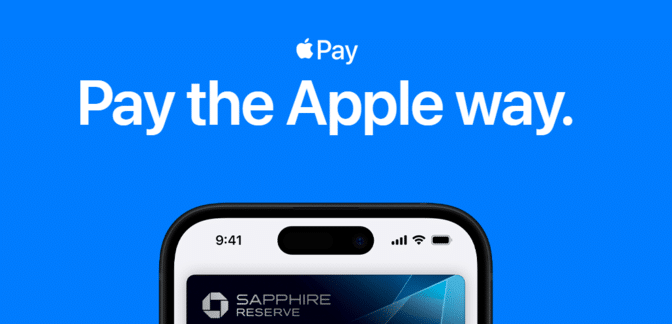
The hospitality industry is continually evolving, with new technology integrations shaping how businesses operate and interact with their customers.
These are some of the most impactful emerging integrations in hospitality tech:
1. AI-Based Integrations for Data Analysis
AI is transforming how businesses in the hospitality sector gather, analyse, and act on data.
Integrating AI-based tools with cloud based POS systems can provide insights that drive better decisions:
- Enhanced Customer Insights: AI-based data analysis tools can track and analyse customer behaviour, preferences, and spending patterns. This lets businesses tailor marketing campaigns, personalise guest experiences, and create targeted promotions.
- Predictive Analytics: AI integrations can predict future trends based on past data, helping businesses prepare for peak periods, adjust inventory, and plan staffing accordingly. This approach minimises waste and improves resource allocation.
- Operational Efficiency: AI can assist in automating repetitive tasks, like inventory replenishment and report generation, freeing up staff to focus on customer service and other critical areas.
2. Contactless Payment Solutions and Digital Wallets
The demand for convenience and speed in transactions has made contactless payment solutions and digital wallets essential integrations for modern hospitality businesses:
- Enhanced Guest Experience: Contactless payment methods like Apple Pay offer customers a quick and seamless way to pay. This not only speeds up the checkout process but also meets the growing expectation for hygienic transactions.
- Improved Payment Security: Contactless payment solutions are equipped with advanced security features that protect customer data and reduce the risk of fraud.
- Wider Payment Options: By integrating contactless payment systems, businesses can offer flexible payment options that cater to diverse customer preferences, boosting customer satisfaction and potentially increasing sales.
3. Integrations Supporting Sustainability
Sustainability is a growing focus for both businesses and customers in the hospitality industry.
Integrating eco-friendly tools that support sustainability can help businesses meet these expectations while improving their bottom line:
- Reducing Food Waste: Waste reduction tools such as Winnow track food usage and waste patterns. Through AI-powered image recognition and data analytics, these tools can identify areas where food waste is most prevalent and suggest adjustments to inventory and menu planning. This leads to cost savings and aligns with sustainable business practices.
- Eco-Friendly Inventory Management: Integrations that monitor and manage inventory efficiently can prevent over-ordering and reduce spoilage, supporting a more sustainable supply chain.
- Customer Engagement with Sustainability Initiatives: Sustainability-focused integrations can also inform customers of a business’s eco-friendly practices, fostering a positive brand image and appealing to environmentally conscious consumers.
Emerging integrations in hospitality tech are setting the stage for a more data-driven, customer-centric, and eco-friendly future.
By adopting these tools, hospitality businesses can stay competitive, improve their operations, and meet the evolving expectations of their customers.
Tips for Choosing the Right Integrations
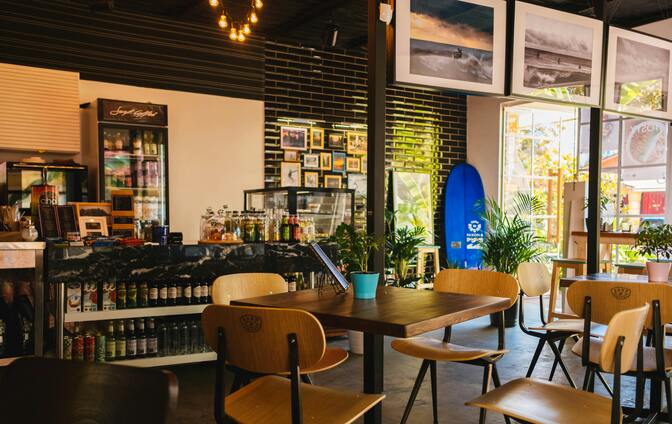
Selecting the best integrations for your cloud EPOS system is crucial to ensuring that your business reaps maximum benefits.
Below are some key tips to guide you in making the right choices based on the type and size of your business’ unique needs:
1. Considerations Based on the Type and Size of Your Hospitality Business
Integrations should align with your specific business needs and scale.
Here’s how to approach this based on different types and sizes of hospitality businesses:
- Small Cafés and Independent Restaurants: Focus on integrations that address core needs without overwhelming your system or budget. Essential integrations might include basic reservation software, simple loyalty programs, and inventory management tools.
- Mid-Sized Restaurants and Chains: For businesses with higher traffic and multiple locations, consider more robust integrations that support multi-location management, CRM systems, and employee scheduling tools. These standardise operations and maintain consistency across all sites.
- Large-Scale Hotels and Hospitality Groups: Larger operations need scalable integrations. This includes integrating with property management systems (PMS), accounting software, CRMs, and real-time inventory management systems.
- Type of Establishment: A fine dining restaurant might benefit more from high-level reservation and customer experience integrations, while a fast-casual eatery might prioritise third-party delivery platforms and staff management tools.
2. Budget and ROI Analysis
Investing in integrations should be seen as a strategic move that enhances your profitability over time.
Conduct a budget and ROI analysis to ensure that the integrations you choose are both cost-effective and beneficial in the long run:
- Initial Costs vs. Long-Term Savings: Weigh the initial setup costs of integrations against the potential savings they offer in terms of time, labour, and operational efficiency. For instance, an investment in automated inventory management may have upfront expenses but can significantly reduce waste and manual tracking costs over time.
- Subscription and Maintenance Fees: Some integrations come with ongoing subscription fees or maintenance costs. Make sure to factor these into your budget and compare different providers to find the best value for your needs.
- Projected ROI: Evaluate how each integration can contribute to your revenue. For example, integrations with loyalty programs may encourage repeat business, while employee scheduling tools can reduce labour costs.
- Trial and Pilot Programs: Take advantage of free trials or pilot programs offered by integration providers. This allows you to test the compatibility and effectiveness of the software before committing to a long-term contract.
- Integration Compatibility and Future Growth: Choose integrations that are compatible with your current cloud EPOS system and can scale as your business grows. This ensures you won’t need to overhaul your entire system when your operations expand, saving on future costs and disruptions.
Selecting the right integrations requires balancing practicality, financial feasibility, and strategic fit.
By carefully considering your business type and scale, and performing a thorough budget and ROI analysis, you can make informed decisions that enhance your cloud EPOS system’s capabilities and support your long-term business goals.
Integrations for Boosting Functionality

Strategic integrations can turn a standard cloud EPOS system into a powerhouse of functionality, tailored to meet the diverse needs of a hospitality business.
Without integrations, an EPOS system may handle basic sales and payment functions effectively, but it won’t fully maximise efficiency. By incorporating certain integrations, businesses can unlock several benefits:
- Streamlined Operations: Integrations enable your EPOS system to communicate directly with other tools and platforms, such as reservation systems and kitchen display units. This leads to smoother service delivery, faster transaction processing, and less operational friction.
- Enhanced Customer Experience: Integrations like CRM and loyalty program software ensure that customer data and preferences are accessible at every point of service. This allows you to offer personalised service, targeted promotions, and a superior guest experience.
- Unified Management of Multiple Business Functions: From inventory tracking and accounting to employee scheduling and performance monitoring, integrations centralise these functions within the EPOS system. This not only makes it easier to track of day-to-day operations and provides a view of the business’s health in real time.
- Improved Data Accuracy and Reporting: When systems like inventory management, financial tools, and customer feedback platforms are integrated, data flows seamlessly between them. This synchronisation ensures that reports generated by the EPOS system are up-to-date and accurate, giving decision-makers more reliable insights for strategic planning and performance reviews.
- Flexibility and Scalability: Integrations offer the flexibility to customise your EPOS system to match the unique needs of your business. As your business grows or your needs change, you can add or modify integrations to scale operations without overhauling your entire system.
- Reduced Costs and Increased Efficiency: Automation helps reduce labour costs by minimising the need for manual tasks and repetitive work. For example, integrating accounting software can streamline invoicing and payroll processing, saving both time and resources.
In general, integrations empower a cloud EPOS system to become more than just a transactional tool; they transform it into a solution that supports every aspect of a hospitality business.
Key Benefits of Cloud EPOS Integrations
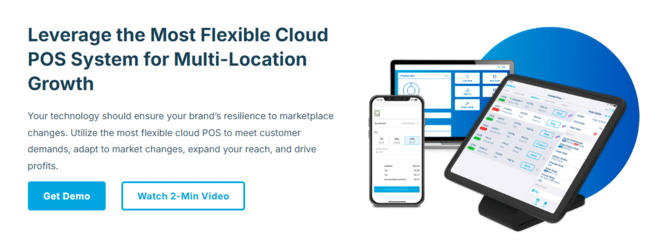
1. Improved Operational Efficiency
Integrating your cloud EPOS with other essential business tools streamlines the flow of information and reduces the need for manual input across different systems. This leads to:
- Automation of Repetitive Tasks: Time-consuming processes like updating inventory, managing orders, and processing payments can be automated through integrations.
- Real-Time Data Synchronisation: Integrated systems ensure that information is updated in real time. For example, when a sale is made, inventory counts adjust automatically, and accounting records are updated instantly.
- Simplified Workflow: With interconnected systems, employees can navigate fewer platforms to accomplish tasks. A single dashboard might display sales data, bookings, and inventory, speeding up decision-making and day-to-day operations.
2. Enhanced Customer Experience
Customer satisfaction is a cornerstone of success in the hospitality industry. Integrations with a cloud EPOS system help elevate the customer experience by enabling personalised and efficient service:
- Personalised Interactions: Integrating with CRM software allows businesses to store customer preferences and feedback. This helps staff offer tailored recommendations and promotions.
- Loyalty Programs and Promotions: Integrations with loyalty platforms enable seamless point collection and reward redemption, encouraging repeat visits and a positive connection with your brand.
- Faster and Contactless Payments: Payment integration supports a range of payment methods, speeding up transaction times and giving customers flexibility in how they pay.
- Enhanced Order Accuracy: When orders are processed through integrated systems that link the front of the house to the kitchen and bar, the chances of errors decrease. This ensures customers receive exactly what they ordered, which boosts satisfaction and reduces complaints.
3. Streamlined Staff Management
Effective management of employees is vital to running a smooth hospitality business, and cloud EPOS integrations can make this easier and more efficient:
- Automated Scheduling: Integrations with workforce management tools help automate shift scheduling, ensuring that staffing levels are optimised to match peak hours and special events. This reduces the burden on managers and improves coverage without overstaffing.
- Performance Tracking: By linking EPOS data with employee management systems, you simplify performance tracking. Metrics such as sales per hour, upsell success rates, and table turnover can be analysed to reward staff or provide targeted training.
- Time Clock Integration: Integrating time-tracking software with your EPOS system allows employees to clock in and out through the same platform, simplifying payroll processing and maintaining records.
- Streamlined Communication: Communication integrations allow managers and staff to send real-time updates, shift changes, and announcements directly within the EPOS system, improving coordination and response times.
Conclusion
Incorporating the right integrations into your cloud EPOS system can transform how your hospitality business operates and serves its customers.
From AI-driven data analysis that sharpens decision-making to contactless payment solutions that cater to modern customer preferences, and sustainability-focused tools that align with eco-friendly practices, these emerging technologies offer substantial benefits.
By carefully considering your business’s type, scale, and budget, and focusing on integrations that deliver a tangible ROI, you can create a streamlined, efficient, and future-ready operation.
Embracing these integrations not only enhances operational efficiency and customer satisfaction but also positions your business as an innovative leader in the ever-evolving hospitality landscape.
To take your hospitality business to new heights, contact NFS Hospitality to find the right cloud EPOS for your operation.
In the restaurant industry, efficiency and adaptability are key to staying competitive.
A cloud-based EPOS (Electronic Point of Sale) system offers a flexible, scalable solution that can streamline operations, enhance customer experience, and boost profits.
If you’re a restaurant owner, you probably already have one in place, but are you leveraging its full potential?
In this guide, we’ll look at practical strategies to maximise your restaurant’s cloud EPOS capabilities—from advanced reporting to seamless integration with other tools—so you can improve service, optimise costs, and ultimately drive growth.
Optimising Order Management and Speed of Service
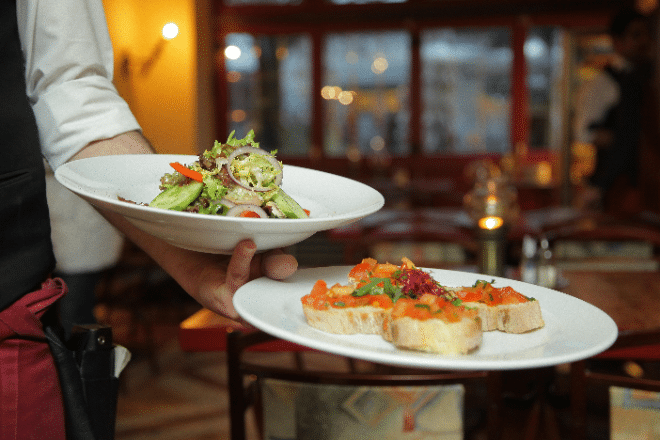
In hospitality, every second counts, and the speed of service can make or break the customer experience. A cloud-based POS system can improve how orders are managed and processed, reducing wait times, enhancing accuracy, and creating a more efficient workflow.
1. Mobile Ordering and Tableside Service
Mobile ordering allows servers to take orders directly at the table using a handheld device, such as a tablet or smartphone. This eliminates the need to run back and forth to a central POS terminal.
Orders are immediately sent to the kitchen, allowing the kitchen staff to start preparing meals without delay, leading to faster turnaround times and an enhanced customer experience.
- Advantages of Mobile Ordering:
- Increased Order Accuracy: Orders entered tableside reduce the chance of miscommunication.
- Enhanced Upselling Opportunities: With customer data and item suggestions readily available, servers can easily offer add-ons or upgrades.
- Streamlined Payment Process: Servers can also process payments at the table, minimising the wait for bills and improving table turnover rates.
2. Integrated Kitchen Display Systems (KDS)
A KDS replaces traditional paper tickets with digital screens that organise and display orders as they come in. This allows kitchen staff to see orders immediately, with colour-coded indicators for priority orders, items ready to be served, and any customisations or dietary requirements.
- Benefits of KDS:
- Reduced Order Confusion: The KDS displays each item’s status, helping chefs and kitchen staff keep track of what needs to be prepared.
- Improved Workflow: Orders are organised by priority, ensuring that dishes are prepared in the correct order, helping the team maintain a smooth workflow, even during rush hours.
- Real-Time Order Updates: If a customer makes a change to their order, the KDS updates immediately, preventing errors and communicating to the kitchen instantly.
3. Order Batching and Efficient Course Management
For large parties or busy times, cloud based systems can batch orders, grouping similar items to be prepared simultaneously. This minimises the time it takes to prepare and deliver each course, creating a seamless dining experience, especially for group diners who expect courses to be served together.
- Batching and Course Control Benefits:
- Reduced Preparation Time: Grouping similar orders reduces prep time and improves kitchen efficiency.
- Enhanced Customer Satisfaction: Guests receive dishes simultaneously, improving the dining experience for larger parties.
4. Self-Ordering Options
Cloud EPOS systems can facilitate self-ordering kiosks or tableside tablets, where customers can place orders directly. This option speeds up service, especially for casual dining settings, by allowing customers to control their experience and reducing wait times
- Self-Ordering Benefits:
- Empowered Customers: Guests can place and customise their orders without waiting, allowing them to enjoy a personalised experience.
- Minimised Errors: When customers place their orders themselves, there’s less room for error, which reduces dissatisfaction and returns.
5. Real-Time Communication and Notifications
Communication between front-of-house and back-of-house staff is crucial for efficient service.
With a cloud based system, any updates on customer orders are instantly shared, and notifications can alert servers when items are ready.
- Real-Time Updates and Notifications:
- Improved Coordination: Real-time notifications allow staff to communicate efficiently, ensuring that orders are served at their best.
- Reduced Wait Times: Prompt communication minimises the time food spends waiting to be served, maintaining quality and customer satisfaction.
Enhancing Customer Experience Through Personalisation

Personalised service can be the key differentiator that keeps customers coming back. A cloud EPOS system can serve as a powerful tool to collect, analyse, and leverage customer data, allowing restaurants to create tailored experiences that build loyalty and drive repeat visits.
1. Using Customer Data to Personalise Service
Every interaction a customer has with your restaurant generates valuable data. Cloud based POS systems can store customer preferences, order history, and special requests, enabling servers to tailor their service accordingly.
- Benefits of Personalised Service:
- Enhanced Customer Satisfaction: Guests feel valued and understood, leading to a more memorable dining experience.
- Streamlined Service: By knowing a customer’s preferences ahead of time, servers can anticipate needs, resulting in a smoother, faster service.
- Improved Staff Confidence: With access to customer data, servers are better equipped to make recommendations that suit each guest’s preferences.
2. Building Loyalty Programs for Repeat Visits
Cloud EPOS systems can also help set up and manage customer loyalty programs.
By tracking visit frequency, total spending, and menu preferences, restaurants can create customised loyalty rewards that encourage customers to return. These rewards can be points-based or tied to specific purchases, such as discounts or a free item after a certain number of visits.
- Benefits of Loyalty Programs:
- Increased Customer Retention: Rewards give customers a reason to return, driving repeat business and establishing a loyal customer base.
- Enhanced Guest Engagement: A well-designed loyalty program can engage guests with exclusive offers, such as early access to new menu items or special event invitations.
- Data-Driven Insights: As customers participate, their preferences and spending patterns provide deeper insights into what drives repeat business, helping you refine your offerings.
3. Tailored Promotions Based on Customer Insights
Cloud EPOS systems allow you to segment customers based on factors such as purchase frequency, meal preferences, and average spend.
With this data, you can create targeted promotions that resonate with specific customer groups, maximising the impact of each campaign.
- Examples of Targeted Promotions:
- Birthday Offers: Automatically send a special offer or discount for a customer’s birthday, encouraging them to celebrate at your restaurant.
- Seasonal Discounts: Offer discounts on popular items based on seasonal trends or past customer behaviour, such as summer cocktails or holiday desserts.
- Customised Upsell Opportunities: Use data to suggest add-ons that align with customers’ preferences, such as wine pairings or dessert options.
4. Improving Marketing with Real-Time Feedback
Customer data collected through the cloud EPOS system provides real-time insights into what’s what isn’t. By analysing this data, you can adapt promotions, menus, and service strategies based on customer responses.
- Benefits of Real-Time Feedback:
- Quick Adaptability: Immediate access to customer feedback lets you make adjustments on the fly, ensuring your offerings stay relevant.
- Enhanced Marketing Effectiveness: Promotions and offers are based on actual customer preferences and behaviours, leading to higher engagement and conversions.
- Increased Revenue: With targeted promotions and timely adjustments, you can maximise the profitability of promotions, reducing waste and increasing the overall spend per customer.
5. Automating Personalised Experiences
Many cloud EPOS systems offer automation tools that allow you to set up personalised messaging or promotions that are triggered by specific customer behaviours.
- Advantages of Automation:
- Consistent Engagement: Automated messages keep your restaurant top-of-mind for customers, especially those who may need a reminder to visit.
- Effortless Personalisation: Automation allows you to maintain personalised engagement at scale, without requiring constant manual input.
- Boosted Loyalty: Automated re-engagement messages help retain customers, strengthening loyalty and reducing the cost of customer acquisition.
Leveraging Data and Analytics for Decision-Making
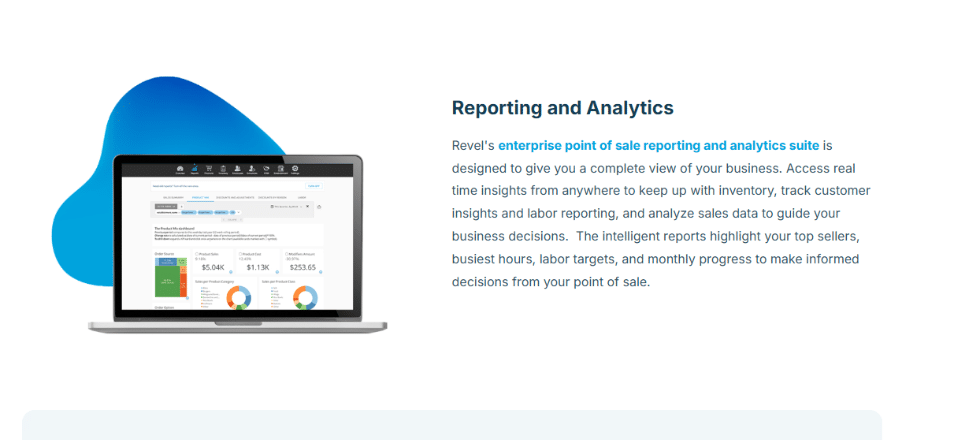
One of the most powerful advantages of a cloud-based EPOS system is its ability to collect and analyse vast amounts of data.
By providing detailed reports on sales, peak times, customer preferences, and more, a cloud EPOS system equips restaurant managers with the insights needed to make strategic, data-driven decisions.
1. Sales Analysis for Menu Optimisation
Cloud EPOS systems track each menu item’s performance, allowing managers to quickly identify bestsellers, low-performers, and seasonal favourites.
By reviewing sales data, managers can make data-backed adjustments to the menu—highlighting popular items, rotating out underperforming dishes, and experimenting with new options.
- Benefits of Sales Analysis:
- Boosting Profit Margins: By promoting high-margin items and phasing out less profitable dishes, restaurants can increase revenue with minimal changes.
- Enhancing Customer Satisfaction: Customers are more likely to return if the menu features items that align with their preferences and popular demand.
- Reducing Waste: By understanding which items sell well and which don’t, managers can adjust order quantities, minimising waste and lowering inventory costs.
2. Identifying Peak Times for Efficient Staffing
A cloud EPOS system’s data can reveal peak hours, busy days, and seasonal trends, helping managers determine when to schedule more staff or when it may be feasible to operate with a leaner team.
This data-driven approach to staffing ensures that service remains efficient without overspending on labour during slower periods.
- Advantages of Peak Time Analysis:
- Cost Savings: Optimised staffing means reduced labour costs during off-peak times, allowing for better budget management.
- Improved Service Quality: With the right number of staff during busy hours, wait times decrease, and customer satisfaction improves.
- Employee Morale: Consistent staffing levels help prevent burnout among employees during rushes and ensure they’re supported during high-demand times.
3. Tracking Customer Preferences for Tailored Offerings
Cloud EPOS systems can track customer preferences and buying patterns, offering insights into common modifications, dietary requests, and popular pairings.
This allows restaurants to tailor offerings, add popular items to the menu, or create upsell opportunities that resonate with customer tastes.
- Benefits of Understanding Preferences:
- Personalised Marketing: Managers can create promotions and menu items that appeal directly to their audience.
- Enhanced Guest Experience: Catering to popular demands and preferences fosters customer loyalty and satisfaction.
- Strategic Menu Development: Insights into preferred flavours or dietary needs (e.g., vegetarian or gluten-free) guide decisions when adding or modifying dishes.
4. Inventory Management and Waste Reduction
Effective inventory management is essential to maintaining profitability and sustainability.
A cloud EPOS system can track inventory in real time, correlating sales data with stock levels to predict shortages or prevent overstocking.
- Inventory Management Benefits:
- Reduced Waste: Inventory analytics allow managers to make precise purchasing decisions, reducing spoilage and waste.
- Cost Control: With clear insights into what’s being used and sold, managers can avoid unnecessary expenses on excess stock.
- Supplier Optimisation: Historical data on ingredient usage and demand can be shared with suppliers, enabling more accurate ordering and potentially better pricing on bulk orders.
5. Budget Forecasting and Financial Planning
Cloud EPOS data can assist with budget forecasting by analysing revenue trends, high-margin items, and cost patterns.
Understanding which days or weeks generate the most income allows managers to plan promotions and allocate resources effectively, while the breakdown of revenue per menu item assists in strategic pricing.
- Financial Planning Advantages:
- Accurate Budgeting: Real-time insights into sales and costs allow for more accurate financial forecasting and planning.
- Informed Investment Decisions: Revenue data helps determine when it’s financially viable to invest in new equipment, renovations, or marketing campaigns.
- Profit Maximisation: A well-informed pricing strategy based on historical data can maximise profits by adjusting prices without affecting demand.
6. Benchmarking Performance Over Time
Cloud EPOS systems often allow restaurants to compare performance over different periods. This benchmarking provides valuable insights into trends, seasonality, and long-term growth, helping managers set realistic goals and measure success.
- Benefits of Performance Benchmarking:
- Goal Setting and Tracking: Setting benchmarks allows managers to track progress, celebrate achievements, and identify areas for improvement.
- Seasonal Trend Analysis: Comparing data across seasons reveals predictable trends, allowing for pre-emptive stock and staffing adjustments.
- Informed Strategic Planning: Benchmarking data over years informs high-level decisions, such as expansion or renovation plans, based on consistent growth metrics.
7. Making Real-Time Adjustments with Live Data
Unlike traditional POS systems, cloud EPOS systems offer real-time data that allows managers to make on-the-spot adjustments as needed.
Whether it’s identifying a sudden surge in demand for a particular item or recognising an unexpectedly busy period, managers can respond immediately to ensure smooth operations.
- Advantages of Real-Time Adjustments:
- Quick Adaptability: Real-time data lets managers make immediate changes, like restocking popular items or adjusting staff assignments.
- Improved Customer Experience: Swift adjustments based on live data ensure that customer service is not compromised during peak times or unexpected rushes.
- Operational Efficiency: Proactive decision-making based on real-time data reduces disruptions and keeps the team aligned with current demand.
Conclusion
Efficiency, flexibility, and data-driven decision-making are key to success. A cloud based system provides the robust tools needed to streamline operations, enhance the customer experience, and support your business as it grows.
By optimising order management, leveraging real-time data for strategic decisions, and personalising both service and marketing, a cloud POS system is much more than just a point-of-sale tool—it’s a comprehensive platform for growth.
As you consider ways to improve your restaurant’s operations, consider reaching out to the experts at NFS Hospitality to find a POS system that works for you and your business.
In hospitality, staying ahead of the competition means embracing technology that enhances efficiency, improves customer service, and streamlines operations.
One solution successful restaurants are turning to is cloud-based EPOS (Electronic Point of Sale) systems.
Unlike traditional systems, cloud EPOS offers greater flexibility, real-time data access, and seamless integration with other tools.
This shift to the cloud empowers restaurants to operate more efficiently, deliver exceptional customer experiences, and adapt quickly to industry changes.
1. Real-Time Data and Analytics
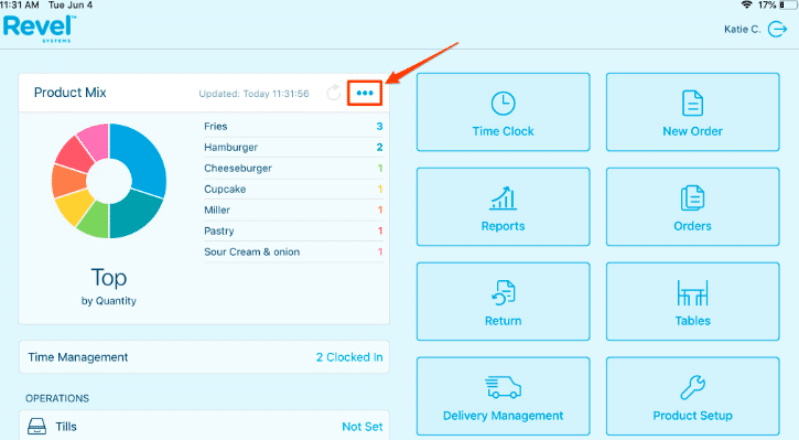
Cloud-based systems grant the ability to access real-time data from anywhere, on any device with an internet connection.
Traditional systems generally require on-site access or manual syncing, limiting flexibility and slowing down critical decision-making. Cloud based POS systems allow restaurant owners to stay connected with their business at all times, whether they’re on the floor, in the back office, or offsite.
Sales Data at Your Fingertips
With real-time access to sales data, restaurant operators can monitor transaction activity as it happens.
This provides a clear and immediate view of top-selling items, sales trends, and peak business hours, allowing for on-the-fly adjustments.
Whether it’s deciding to push a high-margin item during a busy shift or adjusting staffing levels based on current sales, having this data instantly available leads to smarter, more responsive decisions.
Inventory Monitoring and Control
A cloud EPOS system can manage inventory levels in real-time.
As orders are processed, stock levels are updated automatically, providing a live snapshot of what’s in the kitchen and what’s running low.
This also allows for better planning and cost control, helping restaurants avoid waste and ensuring that you always have what you need to meet customer demand.
Customer Data Insights
Cloud based POS systems also allow for the collection and analysis of customer data.
The system can track customer preferences, order history, and spending habits. This can be used to tailor promotions, design personalised marketing campaigns, and enhance loyalty programs, all aimed at improving customer retention and boosting repeat business.
Smarter Decision-Making and Performance Tracking
This real-time data means restaurant operators can make informed decisions quickly.
Whether it’s optimising menu offerings, adjusting pricing strategies, or managing labour costs, cloud EPOS provides actionable insights that are crucial for running a profitable restaurant.
Performance tracking also becomes more accurate, allowing managers to monitor KPIs like average spend per customer, table turnover rates, and staff productivity—all in real time.
2. Enhanced Flexibility and Remote Access
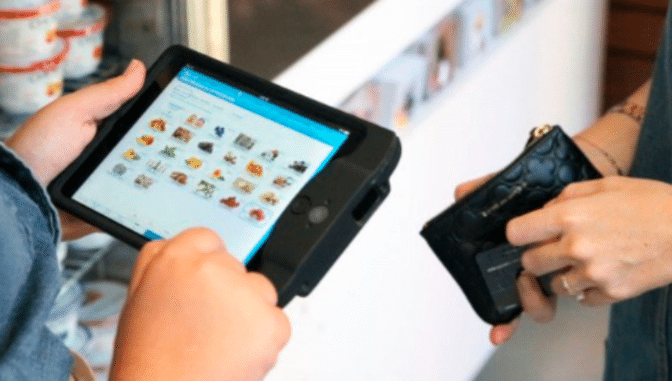
Cloud POS provides remote access, allowing restaurant owners and managers to oversee operations from anywhere in the world, as long as they have an internet connection.
This flexibility offers unparalleled convenience and control.
Manage Your Restaurant from Anywhere
With a cloud based EPOS system, restaurant management is no longer confined to a single location.
Owners and managers can log in remotely to monitor sales, track inventory, and analyse performance metrics in real time.
Remote access also allows managers to perform critical tasks like updating menus, changing prices, and reviewing staff schedules from anywhere.
Streamlining Operations for Multi-Location Restaurants
For chains or those with multiple locations, cloud EPOS systems offer a powerful advantage in maintaining consistency across the brand. Managing several locations with a traditional, standalone point of sale system can result in disjointed operations, data silos, and inefficiencies.
With a cloud-based system, data from different locations is centralised, allowing for seamless access and management across the board.
Managers can compare performance metrics between locations, identify underperforming branches, and implement improvements swiftly. Menu updates, promotional campaigns, and pricing adjustments can be rolled out across all sites instantly.
Empowering Multi-Tasking and Collaboration
Accessing the system remotely facilitates better collaboration between staff and managers, even when managing multiple locations.
The cloud-based nature of the system allows for seamless communication between kitchen staff, servers, and management, reducing errors and improving service delivery.
Flexibility to Scale with Your Business
As your restaurant business grows, cloud EPOS systems provide the flexibility to scale without the need for costly hardware upgrades or complex system integrations.
New locations can be added to the platform with ease, and data from all sites remains accessible in one central hub. This scalability ensures that the EPOS system grows with your business, helping you to maintain operational consistency and high service standards as you expand.
3. Streamlined Inventory and Supply Chain Management
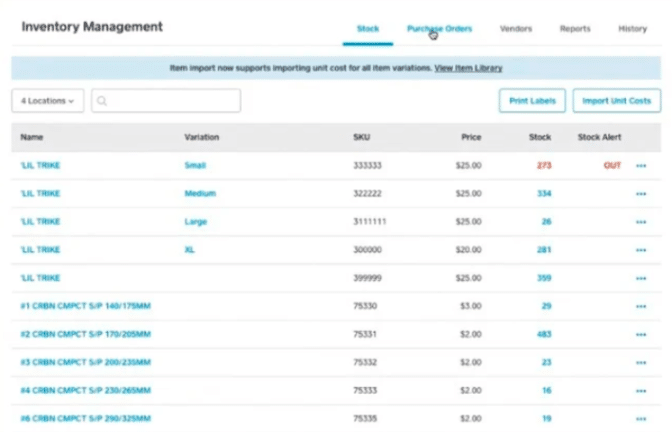
With real-time tracking, automation features, and seamless integrations, cloud EPOS transforms the way restaurants manage stock levels, interact with suppliers, and control costs.
Monitoring Stock Levels in Real-Time
Cloud POS systems allow restaurant operators to monitor inventory levels in real time, ensuring that stock counts are always accurate.
As items are ordered and processed through the system, the inventory is automatically adjusted. This eliminates the need for manual stock checks, reducing the risk of human error.
Real-time monitoring also lets restaurants identify trends in product usage, helping managers anticipate busy periods and adjust stock levels accordingly. This reduces waste, prevents overstocking, and ensures that popular items are always available during peak hours.
Automated Reordering
Cloud EPOS systems can be configured to automate the reordering process, ensuring that key ingredients and supplies are replenished before they run out.
When stock levels reach a predetermined threshold, the system can automatically trigger orders to suppliers, reducing the risk of shortages that could impact service quality. This not only saves time for managers but reduces the likelihood of costly last-minute orders or rushed deliveries.
Preventing Shortages and Overstocking
One of the biggest challenges in inventory management is balancing stock levels to avoid shortages and overstocking. Cloud EPOS helps restaurants strike the right balance by providing insights into which items are selling quickly and which are not.
By analysing past sales data, the system can predict demand and suggest optimal stock levels, ensuring that restaurants order just the right amount of each product. This predictive capability reduces waste, lowers food costs, and keeps you prepared to meet customer demand.
Supplier Integration for a Smoother Supply Chain
Another significant benefit of cloud EPOS systems is their ability to integrate with suppliers. Many cloud EPOS platforms allow restaurants to link directly to supplier portals, streamlining the ordering process.
This means that managers can place orders, track deliveries, and even negotiate pricing without leaving the EPOS system.
Restaurants can track order histories, review past invoices, and compare prices, making it easier to manage supplier relationships and optimise purchasing decisions.
Cloud EPOS systems can also be integrated with accounting software, allowing for seamless financial tracking and ensuring that costs are recorded accurately in real time.
Enhancing Supply Chain Efficiency
These systems provide better visibility into the entire supply chain. Managers can track orders from suppliers, monitor delivery times, and identify any delays or disruptions that could impact the kitchen.
This visibility helps restaurant operators react quickly to supply chain issues, whether that means finding an alternative supplier or adjusting the menu to reflect available ingredients.
4. Improved Customer Experience

Delivering an exceptional customer experience is key to building loyalty and ensuring repeat business.
Cloud EPOS systems play a significant role in enhancing this experience by streamlining operations, reducing wait times, and offering personalised service.
Additionally, features like loyalty program integration and online ordering provide added convenience for customers, helping restaurants stand out in a crowded market.
Faster Order Processing and Reduced Wait Times
One of the most immediate ways cloud EPOS systems improve the customer experience is by speeding up order processing. With orders entered directly into the system and instantly sent to the kitchen, the risk of errors is reduced, and service becomes more efficient.
Servers can quickly take orders via tablets or mobile devices, eliminating the need for handwritten notes or trips back and forth to the terminal. This ensures that orders are processed faster, which in turn reduces wait times for customers.
Restaurants with busy takeout or delivery services can also streamline order management. Orders placed online or through third-party apps are automatically integrated into the system, reducing delays and ensuring that both in-house and delivery customers receive their meals promptly.
Personalised Service Through Customer Data
Cloud EPOS systems allow restaurants to offer more personalised service.
By storing customer data, including past orders, preferences, and even allergy information, restaurants can tailor the dining experience to individual guests.
This level of personalisation helps build stronger relationships with customers.
Restaurants can also use customer data to send personalised offers, discounts, or event invitations, further improving customer satisfaction and encouraging repeat visits.
Whether it’s sending a birthday promotion or offering a discount on a frequently ordered item, these targeted marketing efforts can significantly boost customer engagement and loyalty.
Loyalty Program Integration
Many cloud EPOS systems come with built-in loyalty program features, making it easier for restaurants to reward their most loyal customers. Instead of relying on physical punch cards or manually tracking points, cloud EPOS systems automatically track customer spending and reward points.
This allows restaurants to seamlessly implement and manage loyalty programs, encouraging customers to return more often.
For customers, loyalty program integration simplifies the process of earning and redeeming rewards.
Whether they dine in or order online, their points are tracked across all platforms, making it easy for them to accumulate rewards and enjoy benefits like discounts, free items, or exclusive offers.
Online Ordering and Delivery Integration
The growing demand for online ordering and delivery has made it essential for restaurants to have a system that can efficiently handle both dine-in and remote customers.
Cloud EPOS systems can integrate seamlessly with online ordering platforms, allowing customers to place orders through a restaurant’s website or app without any extra steps required by staff.
When an order is placed online, it goes directly into the EPOS system, where it is treated like any other order—minimising the risk of errors or delays. This ensures that the kitchen and front-of-house staff remain in sync, even when managing multiple channels of service.
Online ordering integration also allows for greater consistency in customer experience. Customers can easily customise their orders, view menu updates, and even track their delivery, all while their information is saved in the system for future orders.
Seamless Payment Options
Cloud EPOS systems enhance the payment process by offering a variety of payment options.
Whether customers prefer to pay by card, mobile wallets like Apple Pay or Google Pay, or even through contactless options, cloud EPOS ensures a smooth and fast transaction.
In some systems, customers can split bills easily or leave tips digitally, streamlining the checkout process and reducing friction at the end of their dining experience.
5. Employee Management and Scheduling

Managing staff efficiently is critical to running a successful restaurant, and cloud EPOS systems provide powerful tools to simplify this process.
From tracking employee hours to optimising labour costs, these systems help reduce administrative burdens while ensuring smooth operations.
Efficient Management of Employee Hours
Cloud EPOS systems allow for real-time tracking of employee hours, making it easy for managers to monitor attendance and ensure that staff are working their scheduled shifts.
Employees can clock in and out directly through the system, allowing the EPOS to capture exact work times without relying on manual timekeeping methods. This not only reduces the potential for errors but also guarantees accurate payroll.
These systems allow managers to set alerts for overtime or violations of labour regulations, helping them stay compliant with local employment laws.
With this real time data, managers can quickly address any issues, such as late arrivals or early departures, which may impact service quality or labour costs.
Tracking Labour Costs
Labour costs are one of the largest expenses in the restaurant industry, and controlling these costs is vital for maintaining profitability. Cloud EPOS systems offer detailed reporting on labour expenses, allowing managers to track labour as a percentage of sales in real time.
This feature helps restaurants ensure that they are operating within budget and can highlight any instances where labour costs may be disproportionately high.
By analysing labour reports, managers can identify trends, such as overstaffing during slow periods or understaffing during peak hours, and make adjustments to optimise staffing levels.
Automating Employee Scheduling
One of the biggest time-savers provided by cloud EPOS systems is automated employee scheduling.
Rather than manually creating staff schedules each week, managers can use the system to automatically generate schedules based on past sales trends, employee availability, and labour cost goals. This reduces the time spent on administrative tasks and ensures that the restaurant is adequately staffed for every shift.
Automated scheduling also helps prevent common scheduling issues, such as double-booking employees or accidentally leaving key positions unfilled. The system can flag potential conflicts, helping managers avoid problems before they arise.
Reducing Administrative Burden
By automating many of the tasks involved in employee management—such as tracking hours, processing payroll, and creating schedules—cloud EPOS systems significantly reduce administrative workloads for restaurant managers.
Instead of spending hours manually entering data or juggling spreadsheets, managers can rely on the EPOS system to handle these tasks efficiently and accurately.
Better Compliance and Accountability
Cloud EPOS systems can also help restaurants stay compliant with labour laws, for example, ensuring employees receive proper breaks or that overtime is compensated correctly.
The system can be set to track break times and alert managers if an employee hasn’t taken their required break, reducing the risk of labour law violations.
By having accurate records of employee hours and schedules, restaurants can avoid disputes over pay and working hours, leading to greater accountability and transparency in the workplace.
Improved Staff Engagement and Morale
By streamlining scheduling and giving employees more control over their shifts, cloud EPOS systems can also boost staff engagement and morale.
Workers appreciate the ability to easily view and manage their schedules, request time off, or switch shifts with ease. When staff members feel more in control and are better informed about their shifts, it leads to a more positive working environment, which can reduce turnover and improve performance.
6. Cost Efficiency and Scalability
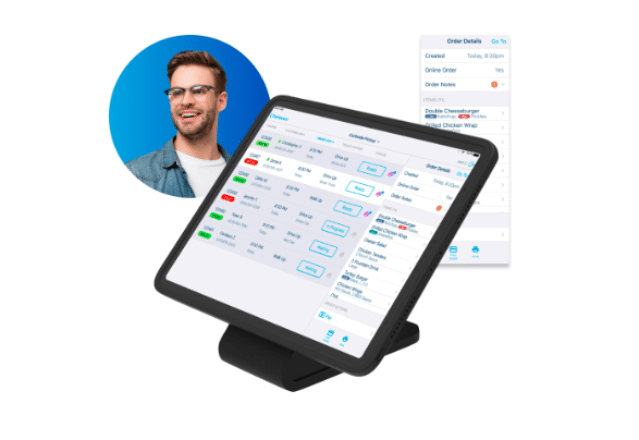
Cloud-based EPOS systems have the potential to deliver significant cost savings and efficiencies.
They reduce the upfront expenses associated with traditional, hardware-heavy solutions and minimise ongoing maintenance fees.
Reduced Upfront Hardware Costs
Traditional EPOS systems often require expensive, specialised hardware like servers, desktop terminals, and networking equipment, which can lead to high initial setup costs. In contrast, cloud EPOS systems rely on off-the-shelf devices like tablets, smartphones, or basic point-of-sale terminals.
Since all the data is stored and processed in the cloud, there’s no need for bulky on-site servers, reducing not only hardware costs but also space requirements in the restaurant.
Minimising Maintenance Fees
In traditional EPOS systems, hardware maintenance and software upgrades can be costly and disruptive. Repairs to hardware like terminals, servers, and printers, as well as regular system updates, often require outside technical support, adding to the overall expense.
Cloud EPOS systems are maintained and updated by the service provider remotely, reducing the burden on restaurant operators. Software updates, security patches, and system improvements are automatically deployed without the need for on-site technicians, keeping the system running smoothly with minimal downtime.
This also means that restaurants always have access to the latest features and security measures without any additional cost, further lowering the total cost of ownership.
Subscription-Based Pricing Models
Many cloud EPOS providers offer subscription-based pricing models, which make it easier for restaurants to manage their cash flow. Instead of paying a large upfront sum for hardware and software, restaurants can spread their costs over time by paying a monthly or annual subscription fee.
This facilitates more predictable budgeting and avoids the need for hefty upfront investments.
These subscription plans typically include customer support, software updates, and data backups, ensuring that restaurants get ongoing value without worrying about hidden costs or surprise fees.
Conclusion
In an increasingly competitive industry, adopting a cloud-based EPOS system can be a game-changer.
From real-time data insights and improved customer experience to streamlined inventory management and cost efficiency, the benefits of cloud EPOS are clear.
Whether you’re a single-location eatery or a growing restaurant chain, cloud EPOS offers the flexibility, scalability, and innovation needed to stay ahead of the curve.
Contact NFS Hospitality to help you find the best platform for your business.
Choosing the right cloud EPOS (Electronic Point of Sale) system for your restaurant is an important decision with the potential to impact your operations, customer experience, and bottom line.
Having a reliable, flexible, and scalable EPOS system is key to streamlining orders, managing payments accurately, tracking and maintaining inventory, and more.
But with so many options available, making the best choice for your restaurant can be overwhelming.
We’ll walk you through the key factors to mull over when choosing a cloud EPOS to ensure it meets your unique needs and supports your business growth.
How to Pick A Restaurant Cloud EPOS
- Examine the Key Features
- Consider Your Restaurant’s Size and Needs
- Think About Integrations
- Review The Pricing Structure
- Look for Good Customer Support and Training
1. Key Features to Look for in a Cloud EPOS
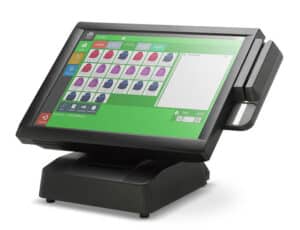
Selecting a cloud EPOS with the features you need can greatly improve efficiency, optimise service, and boost profitability.
These are the essential features you’ll want from any cloud EPOS system:
1. Ease of Use
An intuitive interface is crucial for both front-of-house staff and managers.
You’ll need a user-friendly interface that minimises the learning curve for new employees. Quick, accessible navigation helps staff take orders , process payments, and manage tables easily, reducing errors and wait times.
A system that simplifies your staff’s tasks should lead to faster service, more customer satisfaction, and a smoother experience overall.
The system should offer clear access to data analytics, menu management, employee performance metrics, and sales reports without extensive technical knowledge.
2. Order Management
Order management is a core function of any restaurant EPOS, and it’s important to choose one that handles dine-in, takeaway, and delivery seamlessly.
An efficient cloud based POS system should let staff quickly send orders to the kitchen, split bills for customers, and handle both visits and online orders from third-party platforms like UberEats.
Advanced order management features might include real-time order tracking and alerts to prevent errors and reduce delays, helping you serve your customers faster and more accurately.
3. Payment Integration
Restaurant EPOS systems should support a wide variety of payment methods, including contactless cards, mobile wallets, and digital payment platforms. A smooth, secure checkout process assists the customer experience and reduces bottlenecks during peak hours.
The system should also support split payments and automatic tips, making it easier for groups to settle their bills and for servers to receive gratuities. Integrating multiple payment gateways ensures flexibility and keeps transactions efficient.
4. Inventory Management
Accurate inventory management can prevent food waste and keep your restaurant running smoothly.
POS systems with robust inventory tracking let you to monitor stock levels in real-time, automatically deducting items from inventory as they’re ordered. This feature helps prevent over-ordering or running out of popular menu items, which can negatively impact customer satisfaction.
Some systems offer low-stock alerts, letting you know when to reorder, and detailed reports that identify best-selling items and reduce waste.
This kind of inventory management insight can help control costs and improve profit margins.
5. Table Management
Efficient table management can maximise seating capacity and facilitate a smooth flow of customers.
Built-in table management tools allows hosts and servers to assign tables, manage reservations, and optimise seating arrangements in real-time. This can greatly improve turnover by helping staff manage busy periods and avoid double-bookings.
More advanced systems might include a digital floor plan of your restaurant, allowing you to view table occupancy at a glance.
6. Customer Loyalty and Marketing Features
Building customer loyalty is crucial for repeat business, and POS systems with integrated CRM (Customer Relationship Management) and marketing features can help drive this.
Look for systems that offer loyalty programs, allowing you to reward regular customers with points or discounts. These features help build a connection with your customers and encourage them to return.
Marketing tools that allow you to segment your customer base and send targeted promotions via email or SMS are another great tool for increasing engagement.
7. Staff Management
A cloud EPOS system with integrated staff management features can simplify team management.
Opt for a system that lets you schedule shifts, manage employee timesheets, and track attendance. This streamlines payroll management and guarantees accurate clock-ins and outs.
Performance tracking tools are also valuable.
For example, you can monitor which employees are processing the most orders or generating the highest sales, helping you identify top performers and make informed staffing decisions.
2. Choosing a System That Fits Your Restaurant’s Size and Needs
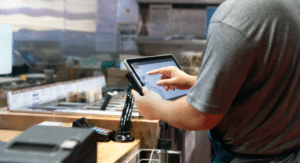
The ideal point of sale should align with your restaurant’s size and specific requirements to maximise efficiency and keep costs in check.
Different types of restaurants, from small independents to large franchises, have varying operational needs, so it’s important to choose a system that suits your business model.
Small, Independent Restaurants
If you’re running a smaller business, cost-effective solutions are likely a priority.
You’ll want a system that offers essential features without overwhelming you with advanced options that you might not need. Look for a restaurant EPOS system that offers flexible pricing plans, ideally with lower upfront costs or pay-as-you-go subscriptions.
Some considerations may include:
- Simplicity: Choose an intuitive system with straightforward features that are easy to set up and manage without requiring extensive technical support.
- Core Features: Ensure that the EPOS covers basic functions like order management, payment processing, and inventory tracking, but doesn’t charge extra for features you won’t use.
- Scalability: Choosing a system that can grow with your business is essential. Make sure the provider offers the ability to add features or upgrade your plan as your restaurant expands.
- Customer Support: 24/7 support is important to resolve issues quickly and keep your hospitality businesses running smoothly.
Franchises and Multi-location Restaurants
Here, scalability and central management are crucial.
You’ll need a cloud EPOS system capable of handling multiple outlets while providing a centralised hub for managing your entire operation.
A few key factors include:
- Centralised Reporting: Your EPOS should consolidate sales, inventory, and employee performance data across multiple locations. This allows for real-time oversight and helps managers make data-driven decisions for each outlet.
- Scalability: This is crucial for future expansion. Ensure the EPOS can easily add new locations and handle increased transaction volumes without a drop in performance.
- Customisable Menus and Pricing: The ability to customise menus and pricing by location is key. Choose a system that allows for menu variations and regional pricing while maintaining centralised control.
- Employee Management Across Locations: Integrated staff scheduling and time tracking tools that work across all outlets are essential for keeping labour costs in check and maintaining consistency in employee management.
- Multi-location Order Management: Whether for delivery, dine-in, or takeout, your EPOS should seamlessly coordinate orders across different branches, allowing for smooth communication between the front-of-house and kitchen in each location.
3. Integration with Other Systems
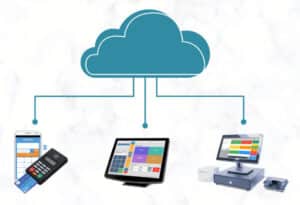
Whether it’s communication between the waitstaff and kitchen or syncing sales data with accounting platforms, seamless integration can boost efficiency and streamline workflows.
Here are some critical integrations to consider:
POS Integration with Kitchen Display Systems (KDS)
Smooth communication between the front-of-house staff and kitchen is vital for getting orders prepared accurately and on time.
A cloud EPOS that integrates with a Kitchen Display System (KDS) enables real-time order tracking and minimises manual errors.
- Improved Order Accuracy: Orders placed at EPOS systems are instantly sent to the KDS, reducing the chances of miscommunication or missed orders. This is particularly useful during busy periods, where human error can really disrupt service.
- Faster Service: The integration allows for real-time updates on order status, helping waitstaff manage customer expectations and improve service speed. Additionally, colour-coded indicators can show order progress, helping you provide timely service.
- Reduced Waste: By minimising manual errors, fewer incorrect orders are prepared, leading to less food wastage and lower costs.
Integration with Accounting Software
Keeping track of your restaurant’s finances is easier when your system integrates with accounting platforms like Xero, QuickBooks, or Sage.
This integration automates the flow of sales data from your EPOS into your accounting software, saving time and reducing the potential for human error.
- Automated Data Entry: Instead of manually inputting daily sales figures, an integrated system automatically transfers sales data, taxes, and expenses to your accounting platform. This saves time and reduces the risk of errors during data entry.
- Real-Time Financial Reporting: With real-time data synchronisation, restaurants can generate up-to-date financial reports to track revenue, profits, and expenses. This allows for better financial decision-making, such as controlling food costs or labour expenses.
- Simplified Payroll and Tax Management: For restaurants with integrated staff management features, payroll data can also be synced with accounting software. This ensures accurate wage calculations and tax filings, helping you stay compliant with local tax regulations.
Third-party Delivery Integration
With the growing popularity of food delivery services, integrating your cloud EPOS with third-party delivery platforms is essential.
This integration helps streamline the management of online orders, ensuring they are processed efficiently without disrupting your in-house operations.
- Centralised Order Management: An integrated system brings all online orders from multiple delivery platforms into a single interface. This allows staff to manage orders from different platforms without juggling multiple devices or apps, reducing the chance of errors.
- Real-time Menu Syncing: Any changes made to your menu, such as pricing updates or item availability, are automatically synced with delivery platforms. This prevents customers from ordering items that are out of stock or incorrectly priced.
- Improved Customer Satisfaction: By reducing order errors and speeding up the process from online order to kitchen preparation, you can enhance the delivery experience, ensuring that customers receive their meals accurately and on time.
4. Cost Considerations
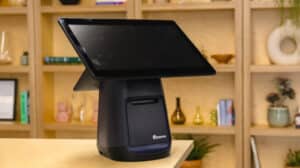
When investing in a restaurant EPOS, understanding the cost structure is essential to making an informed decision. The costs associated with an EPOS system go beyond just the initial setup; ongoing fees and the long-term return on investment (ROI) should also be factored into your decision.
Here’s a breakdown of the primary cost considerations:
Initial Setup Costs vs. Ongoing Fees
One of the most important financial considerations is the difference between upfront setup costs and recurring fees.
POS system providers typically offer subscription-based pricing models, but there may also be additional one-time expenses.
- Initial Setup Costs: These may include the cost of hardware, installation, and any one-off customisation fees. Some offer hardware bundles, while others require you to purchase equipment separately. Installation fees may also apply, particularly if you need help setting up your system.
- Subscription-based Pricing: Most EPOS systems charge monthly or yearly subscription fees. These cover the use of the software, cloud storage for your data, and ongoing support. Subscription costs can vary depending on the number of features included, the number of locations, or the number of users.
- Transaction Fees: Some providers charge a transaction fee on each sale, particularly if you’re using their payment processing services. These can add up, especially in high-volume restaurants, so it’s worth checking the rates and comparing them with third-party payment processors.
- Additional Costs: Other potential expenses might include integrations with third-party software, training for your staff, and any additional licences for extra features like customer loyalty programs.
Long-term ROI
While the initial investment in a cloud EPOS system may seem substantial, the right system can provide significant cost savings and operational efficiencies over time.
Here are some ways in which an EPOS can deliver long-term ROI:
- Reduced Errors: Automated processes like order and inventory tracking help minimise human errors, reducing incorrect orders and food waste. This not only cuts down on operational costs but also improves customer satisfaction, which can lead to repeat business.
- Time Savings: By automating manual tasks like data entry, report generation, and inventory updates, your staff can focus on customer service and improving the guest experience. This time-saving translates into higher productivity and smoother operations.
- Increased Sales: Features like customer loyalty programs and targeted marketing can drive repeat business and encourage upselling. An EPOS system that tracks customer preferences and behaviour allows for personalised promotions that lead to increased sales.
- Better Staff Management: EPOS systems with integrated staff scheduling and performance tracking can optimise labour costs by ensuring proper shift coverage without overstaffing. Additionally, performance reports help identify top performers, allowing for more efficient reward systems that boost productivity.
- Data-driven Decision Making: Access to real-time data allows you to make informed decisions about menu changes, pricing strategies, and staffing needs. With clear insights into your restaurant’s performance, you can identify trends, adjust inventory to avoid overstocking, and streamline operations to improve overall profitability.
5. Customer Support and Training

Effective customer support and staff training are critical when implementing a cloud EPOS system.
Since your EPOS will be at the heart of your operations, any technical issues or disruptions can severely impact your business, especially during busy periods.
Additionally, the ease with which your staff can adapt to the system will influence how smoothly it integrates into your daily operations.
Here’s why these aspects matter:
24/7 Support Availability
Having access to 24/7 customer support ensures that any problems with your cloud EPOS system are resolved quickly, minimising downtime and the risk of lost sales.
- Minimising Disruptions: When a technical glitch arises, especially during peak service hours, you need to know that support is available immediately. Around-the-clock support means that help is available when you need it most, reducing the risk of system outages or operational disruptions.
- Expert Assistance: Ensure that your provider offers access to knowledgeable, well-trained support staff who can quickly diagnose and resolve issues, whether it’s related to hardware, software, or integrations.
- Multiple Support Channels: Look for providers that offer various ways to contact support, including phone, email, live chat, or an online help centre. This flexibility allows you to choose the best method for getting assistance based on the urgency of the issue.
Onboarding and Staff Training
The success of any new EPOS system depends on how easily your staff can learn and adopt it.
Look for providers that offer extensive onboarding and training resources to ensure a smooth transition.
- Easy Onboarding Process: Your provider should offer a clear and efficient onboarding process, including system setup, menu configuration, and integrations. Some providers may offer personalised onboarding assistance, guiding you through the initial setup.
- Training for All Levels: It’s important that both front-line staff and management understand how to use the system effectively. Look for providers that offer multiple training resources to get your staff up to speed and feel confident using the system.
- Ongoing Learning: Beyond the initial training, your provider should offer ongoing learning opportunities to help your team master advanced features over time. This is particularly important as new updates and features are released. Some providers offer online knowledge bases or help centres where you can access guides and troubleshooting tips.
- Multi-language and Location-specific Training: If you operate a multi-location or international restaurant chain, consider whether the EPOS provider offers location-specific training that takes into account local regulations, languages, or currencies.
Conclusion
Choosing the right cloud EPOS system for your restaurant can have a lasting impact on your operational efficiency, customer satisfaction, and overall business growth.
By carefully reviewing key features like ease of use, order management, and payment integration, and ensuring the system fits your restaurant’s size and needs, you can make an informed choice that supports your specific goals.
For a trusted partner in finding the right EPOS for your business, contact NFS Hospitality.
Efficiency and adaptability are key to holding a competitive edge in the hospitality industry.
That’s why successful restaurants turn to cloud-based EPOS (Electronic Point of Sale) systems to streamline operations and customer service, while boosting profitability.
Unlike traditional EPOS systems, a cloud based POS system offers real-time data access, greater flexibility, and seamless integration with other software, making them an essential tool for modern dining.
Reasons Restaurants Use Cloud EPOS
- Streamlining Operations and Reducing Errors
- Improved Customer Experience
- Real-Time Data & Analytics
- Seamless Integration with Other Tools
- Scalability for Growing Businesses
1. Streamlining Operations and Reducing Errors
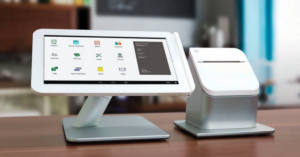
Automating Key Restaurant Tasks
One of the greatest advantages of cloud-based EPOS systems is automating essential restaurant tasks.
Traditional methods of order processing, inventory management, and staff scheduling are prone to human error. Cloud EPOS automates these tasks, ensuring these tasks are managed smoothly and more accurately.
For example, orders placed at the front of the restaurant are instantly sent to the kitchen, reducing the chances of miscommunication or order mix-ups.
Automation not only enhances accuracy but also speeds up service, improving workflow.
Real-Time Inventory Tracking
Restaurant management software helps restaurant managers keep a constant eye on stock levels by automatically adjusting inventory based on sales.
This ensures that restaurants always know what they have in stock, reducing the likelihood of shortages or over-ordering.
Real-time updates allow for more precise control over inventory, helping prevent costly mistakes and wastage.
Optimised Staff Scheduling
Scheduling staff becomes a lot easier with cloud EPOS systems.
By analysing sales and foot traffic data, managers can create more efficient work schedules.
This ensures that the restaurant is neither overstaffed or understaffed at any given time. Additionally, cloud EPOS platforms can integrate with payroll systems, allowing staff hours to be automatically calculated and recorded.
Remote Oversight and Decision Making
With cloud EPOS systems, managers and owners can monitor sales, orders, and operational performance remotely.
This gives them full control over operations, even if they are not physically at the restaurant. Tracking key metrics in real-time helps managers make quick, informed decisions, improving overall oversight.
2. Improved Customer Experience

Speeding Up Service
Cloud EPOS systems significantly improve service speed by allowing orders to be sent instantly from the server to the kitchen.
This reduces wait times and ensures that dishes are prepared more quickly, particularly during busy periods. Whether for dine-in or takeaway, faster service leads to increased customer satisfaction and higher table turnover.
Boosting Order Accuracy
Manual processes often lead to errors, but cloud EPOS systems ensure that orders are accurately recorded and delivered to the correct stations in the kitchen.
Special instructions, such as dietary requirements or modifications, are transmitted in real-time, reducing the risk of mistakes and ensuring customers receive exactly what they ordered.
Offering Flexible Payment Options
Cloud EPOS systems accommodate a wide range of payment processing methods, from traditional cards to mobile and contactless payments like Apple Pay and Google Pay.
This flexibility ensures a frictionless checkout experience for customers, making it easier for them to complete their transactions quickly and conveniently.
Additionally, cloud EPOS systems support split payments and self-checkout options, enhancing customer convenience.
Enhancing Loyalty Programs and Personalised Promotions
Restaurants can leverage the data collected by cloud EPOS systems to create personalised promotions and loyalty programs.
By analysing customer preferences and purchase history, restaurants can offer tailored discounts, special offers, and rewards, fostering customer loyalty.
Integrating these programs directly into the EPOS system makes them easy to manage and track, encouraging repeat business.
3. Real-Time Data and Analytics
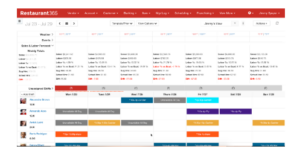
Valuable Insights into Sales Trends
Cloud based POS systems provide restaurants with instant access to detailed sales data.
This allows them to track which menu items are performing well, which dishes may need adjustments, and identify peak sales periods.
With this real-time information, restaurants can quickly spot trends and make data-driven decisions that can enhance their menu offerings, optimise pricing, and boost sales.
Understanding Customer Behaviour
Beyond just tracking sales, cloud EPOS systems offer insights into customer behaviour, such as dining frequency, spending patterns, and preferred payment methods.
By analysing this data, restaurants can tailor their service offerings and create targeted promotions that resonate with their customer base.
For instance, a restaurant might notice that a particular demographic prefers certain dishes, allowing them to create specials that attract repeat business.
Real-Time Inventory Monitoring
Cloud EPOS systems update inventory levels in real-time, allowing restaurants to maintain precise control over stock levels.
This helps reduce waste by alerting managers when items are running low or about to expire.
With a clear view of what’s in stock and what needs replenishing, restaurants can avoid over-ordering or understocking, improving inventory management and reducing the likelihood of wasteful spoilage.
Demand Forecasting for Better Planning
This real-time data also aids in demand forecasting.
By analysing historical sales data and identifying seasonal trends, restaurant owners can predict which items will be in higher demand during specific times.
This allows for more accurate ordering of ingredients and better staff scheduling, helping the restaurant run smoothly, even during peak periods.
Demand forecasting reduces the risk of stock shortages and ensures that the restaurant is prepared to meet customer demand, ultimately boosting profitability.
Boosting Profitability Through Data-Driven Decisions
With real-time analytics, restaurant owners can make strategic decisions to improve profitability.
By tracking metrics like average spend per customer or the performance of special promotions, managers can identify opportunities to maximise revenue.
The ability to reduce food waste, optimise labour costs, and improve overall efficiency through data-driven insights can lead to significant cost savings over time.
4. Seamless Integration with Other Tools
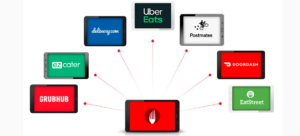
Flexibility in Integrating with Third-Party Applications
One of the standout features of cloud EPOS systems is integration with third-party tools, making them a powerful hub for managing various aspects of a restaurant’s operations.
From accounting software to delivery platforms and customer relationship management (CRM) systems, cloud EPOS systems offer a high degree of flexibility.
This integration centralises operations and reduces the need for manual data entry across different platforms.
Many cloud EPOS systems integrate directly with payroll and accounting tools, such as QuickBooks, Xero, or Sage, helping restaurants automatically sync sales data, calculate staff wages, and generate financial reports with ease.
This eliminates the hassle of transferring data manually and minimises the risk of accounting errors.
Integrating with Delivery Platforms
With the rise of food delivery services, restaurants need to keep up with demand across both dine-in and delivery channels.
Cloud EPOS systems offer integrations with popular delivery platforms like Uber Eats, Deliveroo, and Just Eat, allowing restaurants to manage orders from these services directly.
These integrations help streamline the process by sending delivery orders straight to the kitchen.
This real-time synchronisation prevents any delays or miscommunication between platforms, ensuring a seamless customer experience across all sales channels.
Customer Relationship Management (CRM) Integrations
Cloud EPOS systems also integrate with CRM tools, helping restaurants build and maintain strong relationships with their customers.
By connecting with CRM systems like Salesforce or HubSpot, restaurants can track customer interactions, purchase history, and preferences.
This data can be used to send personalised offers, create tailored loyalty programs, or automate marketing campaigns. Centralising customer data allows restaurants to create deeper connections with their diners, driving repeat business and fostering long-term loyalty.
Streamlining Operations with Kitchen Display Systems (KDS)
Cloud EPOS systems often integrate with KDS to further streamline order management.
Instead of relying on printed tickets or manual processes, orders are instantly sent to digital displays in the kitchen.
This increases the speed and accuracy of order preparation, especially during busy periods.
KDS integrations help ensure that the kitchen and front-of-house teams are always in sync.
Other Useful Integrations
Cloud EPOS systems can also integrate with inventory management systems, reservation platforms, and employee scheduling tools.
These integrations simplify workforce management by automatically pulling sales data to adjust staffing needs based on real-time demand.
Examples of Popular Cloud EPOS Integrations
- QuickBooks, Xero, Sage (Accounting)
- Uber Eats, Deliveroo, Just Eat (Delivery Platforms)
- Salesforce, HubSpot (CRM Tools)
- 7shifts, Deputy (Staff Scheduling)
- MarketMan, BlueCart (Inventory Management)
- Toast KDS, Square KDS (Kitchen Display Systems)
5. Scalability for Growing Businesses
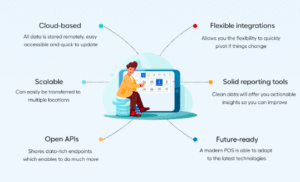
Easily Expand to New Locations
Cloud EPOS systems are designed to scale seamlessly as your restaurant grows.
One of the key benefits of these systems is that they require minimal hardware, making expansion to new locations both simple and cost-effective.
Cloud-based solutions allow you to add new locations to your existing system without the need for additional costly equipment.
The cloud EPOS system is hosted off-site, so there’s no need to install physical servers or network infrastructure. This makes setting up a new location quicker and easier, allowing you to focus on growing your business rather than worrying about complex technical setups.
Centralised Management Across Locations
As your restaurant expands, cloud EPOS provides a unified management platform that lets you oversee multiple locations from a single dashboard.
You can monitor sales, track inventory, and manage staff across all your locations in real time. This centralised control simplifies operations and ensures consistency, no matter how many restaurants you open.
If you’re managing a franchise or chain, cloud EPOS systems allow you to implement company-wide menu changes, promotions, or pricing adjustments instantly.
There’s no need to manually update each location’s system. This centralised approach reduces complexity and ensures that all locations are operating under the same standards and guidelines.
Cost Savings and Reduced Infrastructure Needs
For growing businesses, cloud EPOS systems present significant cost savings.
Cloud-based EPOS systems eliminate the need for expensive servers and hardware at each location, resulting in lower upfront costs and minimal maintenance fees.
Since the system is cloud-based, there are no complicated installations required for new sites.
Most cloud EPOS providers offer scalable pricing plans, meaning you only pay for what you use.
This allows restaurants that experience seasonal fluctuations or gradual expansion to adjust their system needs according to demand without incurring unnecessary expenses.
Adapting to Growth and Change
Cloud EPOS systems are adaptable, making them ideal for restaurants with ambitious growth plans.
Whether you’re opening a second location or expanding into new regions, cloud EPOS can grow with you. As your business scales, the system can accommodate increased transaction volume, more staff, and additional inventory without affecting performance.
This flexibility allows restaurants to expand confidently, knowing that their EPOS system will support their operational needs as they grow.
Streamlined Employee Management
As a restaurant grows, managing a larger workforce becomes more complex.
Cloud EPOS systems can streamline staff management by tracking employee hours, managing shifts, and integrating with payroll systems.
These tools scale with your business, so as you hire more staff across multiple locations, your EPOS system can handle the increased data, ensuring efficient and accurate employee management.
Conclusion
Adopting cloud EPOS systems is not just a trend—it’s a necessity for long-term success. These systems streamline operations by automating key tasks, ensuring order accuracy, and providing real-time data that helps restaurants make informed decisions.
By integrating seamlessly with other tools, such as delivery platforms, accounting software, and CRM systems, cloud EPOS simplifies complex processes and enhances overall efficiency.
The flexibility to manage the restaurant remotely, adapt to menu changes, and expand to new locations without heavy infrastructure investments makes cloud EPOS the ideal solution for growing businesses.
It also elevates the customer experience by enabling faster service, personalised promotions, and a wide variety of payment options.
Ultimately, cloud EPOS systems empower restaurant owners and managers with the tools they need to stay competitive, reduce operational friction, and foster customer loyalty.
For helping finding the right cloud EPOS system for your business, contact NFS Hospitality.
When it comes to selecting a restaurant point of sale solution, there are two choices – either an on premise POS system or a cloud POS solution.
A traditional on premise POS system is typically linked to computer or server on the premises whereas a cloud POS solution is accessed online as all data processing is conducted in the cloud.
Let’s explore the advantages and disadvantages of both approaches so you can make an informed choice – whether you are looking to replace an existing solution or are starting fresh.
What is a cloud-based POS system?
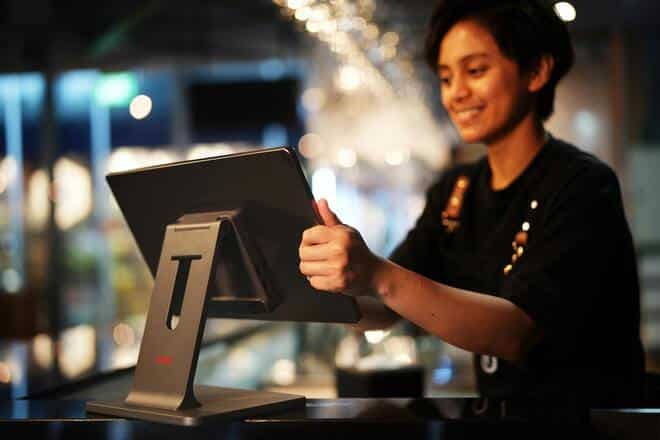
A cloud based POS system or a SaaS (software as a service) based POS system is accessed through the internet.
A key feature of a cloud based POS system is that it doesn’t require a dedicated POS terminal – it will work happily on an iPad, a desktop PC or an Android tablet. It can, therefore, be a lot more portable than the traditional on premise POS system which is based around dedicated fixed terminals.
In terms of core functionality, a cloud POS solution will perform the same tasks as an on premise POS system – managing stock, printing receipts and processing orders.
What are the advantages of a cloud-based POS system?
The advantages of a cloud-based POS system are:
Remote access
With a cloud-based POS system you are not tethered to a physical location. You can run reports on the business from anywhere in the world with an internet connection.
Data security
SaaS technology is incredibly resilient. All data is backed up online in the cloud so even if you drop and break your iPad – no problem – the data is still there, protected and readily available.
Scalability
As restaurant operators grow their business it will be necessary for the POS system to be scaled up when needed to match their business size. Cloud POS systems are designed with scalability in mind so that restaurateurs can choose to scale up the POS without spending too much time, effort, and budget. Adding additional users and sites is straightforward.
Business insights
A cloud POS system enables you to track all transactions, or sale histories so you can view this information anywhere at any time with real-time data synchronisation. This is a great feature for multi-site operators as they can get a holistic view of their business in real-time at the touch of a button.
Choice of hardware
With an on premise POS system you are limited to relatively expensive and largely immobile terminals. With cloud POS systems you can use an iPad or Android tablet for table service or a desktop PC at the front desk. With appropriate accessories such as stands and cash drawers you can also use the tablet front of house as well as tableside.
Regular updates
The beauty of a cloud-based POS system is that all updates are rolled out automatically and there is no need for additional software installation. You can enjoy new features and benefits straight away at no additional cost!
What are disadvantages of a cloud POS solution?
While it is a great option, there are a few disadvantages to selecting a cloud POS solution:
Requires good internet
If you are in a location where internet is intermittent it may be prudent to consider an on premise POS system. A bad connection will at best impede service and, at worst, cause your POS system to fail completely with a potential loss of data.
Non-customisable Solution
POS cloud software solutions do not allow room for customisation. This poses no problem for small operators who lack time and budget for such upgrades. However, larger operators may prefer to be able to make changes to reflect their brand and/or their specific requirements.
Limited customer support
While they typically offer online support, cloud-based POS systems often do not require tailored support as they are usually intuitive and easy to use. For larger operators, a traditional on premise POS systems may be more suitable as support for these platforms can be tailored to suit their needs.
What are the advantages of an on premise POS system?
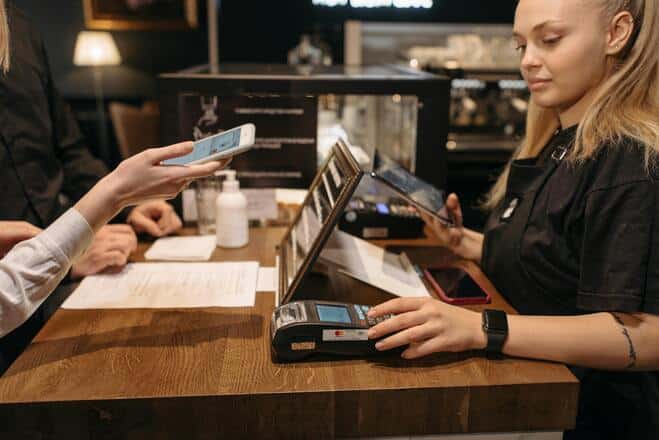
A traditional on premise POS system has some distinct benefits over its POS cloud counterparts. Simply, it is a perfect option for large enterprises and restaurants.
Not relying on the internet
Unlike cloud POS, a traditional system does not depend on the internet as servers are in a closed network. POS can work smoothly and efficiently with the Wi-Fi disconnection.
One-time payment
Most of the time, a traditional POS is sold with a one-time cost. Unlike the monthly subscription fee of cloud POS, you only pay once to own an on premise POS.
Full control and customisation
On premise POS systems reside entirely on your own servers, giving you complete control over the software configuration and customisation. You can tailor the system to your business’s specific needs and processes.
Data security and privacy
With on premise POS systems, your sensitive business data remains entirely within your physical premises. This enhanced security reduces the risk of data breaches or unauthorized access compared to cloud-based systems that store data remotely.
Faster transaction processing
On premise POS systems typically offer faster transaction processing compared to cloud-based systems, as they don’t rely on internet connectivity for data transfer and processing. This can be crucial for businesses with high transaction volumes.
Offline operation
On premise POS systems can operate independently of an internet connection, ensuring uninterrupted transactions even during network outages or power disruptions. This is crucial for businesses that rely on their POS systems for critical operations.
Local support and expertise
On premise POS systems typically provide local support from the provider or their authorized partners. This can be more convenient for businesses that need immediate assistance or prefer face-to-face interactions with support personnel.
What are the disadvantages of on premise POS system?
On premise POS systems also have certain disadvantages that may make them less appealing for some operators:
Higher initial investment
On premise POS systems involve a higher upfront cost due to the hardware and software purchase requirements. You’ll need to purchase or lease servers, manage hardware maintenance, and invest in software licenses.
Technical expertise required
On premise POS systems require technical expertise to install, configure, and maintain the software and hardware components. Businesses may need to hire IT staff or rely on external consultants to manage their POS infrastructure.
Limited scalability
On premise POS systems may have limited scalability in terms of the number of users or transactions they can handle. Adding more hardware or software components can become expensive and complex.
Data security concerns
While on premise POS systems offer greater data security, potential security breaches can still occur due to human error, malware attacks, or hardware malfunctions. Businesses need to implement proper security measures and regularly conduct backups.
Software updates and patches
On premise POS systems require businesses to manually install software updates and security patches, which can be time-consuming and error prone. Missed updates can leave the system vulnerable to security risks.
How to Choose the Right POS System for Your Restaurant
Selecting the best restaurant EPOS or cloud POS solution depends on your business’s specific needs. Consider the size of your restaurant, transaction volumes, and internet reliability.
For instance, a busy restaurant with high turnover may prioritise speed and offline capability, making an on-premise POS appealing. Meanwhile, smaller restaurants or multi-location operators often prefer cloud POS systems for scalability and remote management capabilities.
Integrating POS Systems with Other Restaurant Technologies

Modern restaurant EPOS and cloud POS systems can integrate seamlessly with other technologies, like kitchen display systems, inventory management software, and customer loyalty programs. These integrations streamline operations, reduce human error, and improve the customer experience.
For example, a cloud POS system can automatically update inventory levels in real time when orders are processed, saving time and effort for staff.
Cloud POS for Multi-Site Restaurants: A Game Changer
For restaurant groups or multi-location operators, a cloud POS system offers unparalleled convenience. These systems centralise data management, enabling owners to track performance across all sites in real time.
Whether analysing sales trends or making menu adjustments, a cloud POS ensures consistency and efficiency across locations.
Cost Comparison: On-Premise vs. Cloud POS Systems
An on-premise POS typically involves a higher initial investment, including the purchase of servers, dedicated hardware, and software licenses. These systems often require ongoing maintenance, which can lead to additional costs for technical expertise or IT staff.
A cloud POS system operates on a subscription model, spreading costs over time with a predictable monthly or annual fee. This reduces the upfront expense. Hardware requirements for cloud POS solutions are generally more flexible and affordable, as they can run on devices like tablets or desktop PCs.
For restaurant EPOS systems, the right choice depends on the its operational needs. Either way, choosing the right system can deliver a strong return on investment (ROI) by streamlining operations and enhancing efficiency.
Conclusion
Both cloud POS systems and on premise POS systems have their pros and cons. Generally speaking, cloud POS systems are an affordable option for smaller operations whereas on premise is ideal for larger operators particularly those where speed and volume are paramount.
An on premise POS system offers greater control, security, and offline capability, but they require higher upfront investment, technical expertise to implement and maintain, and need ongoing maintenance. With faster transaction speeds and specialised hardware, they are a good choice for, say, quick service.
Cloud POS systems offer a convenient approach to managing hospitality operations. They provide restaurants with 24/7 access, scalability, and flexibility. A POS cloud based system also simplifies updates and maintenance, ensuring that businesses always have the latest features and security patches. Additionally, a POS cloud based system offers real-time data insights, enabling businesses to make informed decisions about inventory management, marketing, and customer service.
At NFS we offer a best of breed approach as one size does not fit all. We recommend solutions which will meet your needs today and into the future.
Contact us today so we can discuss which option best meets your needs.
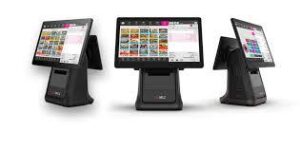
Choosing the right restaurant POS system for your business is the best way to up its efficiency.
To summarise, EPOS systems (or electronic point of sale systems) are an end-to-end solution to all manner of daily problems in the hospitality industry.
They cover everything from payment processing and stock control, to table management and custom pricing. Hospitality Businesses also use them to track online orders and dispense digital receipts.
Good POS systems can manage all this and more across multiple locations, while providing a wealth of reporting features to make sure you get the most out of your tools.
Best POS Systems Available

Aloha is designed as a holistic solution for restaurant EPOS management across multiple locations.
The system is easy to use, but extensive and regularly updated to meet the evolving needs of restaurant owners, while offering stellar customer support.
Aloha excels in managing the entire process from ordering to delivery, with a suite of cloud-based support features.
Where the Aloha point of sale system truly thrives is in its management of stock control, labour, payroll, and other back-house operations.
The key focus of the system is automation of these processes.
Ease of Use
Aloha scores major points for its accessible, easy-to-understand user interface.
Anyone familiar with Windows will have no trouble using Aloha and its layout can be easily customised to suit the needs of you and your staff.
Customer Experience Management
Aloha provides everything restaurant owners need to integrate their customer loyalty programs with the EPOS, as well as the means to customise orders and split bills easily.
Reporting and Analytics
Clear, actionable reporting and pertinent insights on inventory management, sales, and staffing costs are included.
Compatibility
The system integrates well with a range of other services and software such as payroll and accounting tools.

For an all-purpose restaurant EPOS that’s easy to set up, frequently updated, and scalable, consider Revel. This POS system is designed to support both front-of-house and back-of-house operations.
It provides robust controls for menus, stock management ordering, and reporting.
In a market where point of sale systems are becoming increasingly overcomplicated, Revel’s simplicity is one of its greatest strengths.
Revel is optimised for order accuracy and provides tools for preventing delays and boosting customer satisfaction through tableside ordering.
More advanced features include the ability to map out a unique floor plan for individual sections of your restaurant for seamless order management, schedule management, and focused reporting.
Ease of Use
Revel’s design and user interface are simple and adaptable, with a personalised onboarding process that provides guidance on both the hardware and operating system.
Customer Experience Management
Customer retention is one of Revel’s primary concerns. The platform contains various tools for loyalty programs, customer relationship management, discounts, gift cards, and online ordering.
Reporting and Analytics
This restaurant EPOS Operations Report feature combines critical data on sales, order history, product mix, and more into one detailed report, providing a holistic view of the business’ performance.
Compatibility
Revel is designed for compatibility with your existing EPOS hardware, but replacing old systems with their solutions is recommended to get the most out of their impressive suite of features.
Pricing
The comprehensive monthly package comes in at around £80 per month.
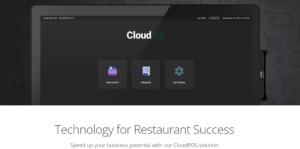
CloudPOS is an easy-to-use restaurant EPOS system with multiple features designed to assist order management, integrated payments, sales reports, online ordering, and more.
Better yet, CloudPOS kitchen display system and other user interfaces are built from the ground up for accessibility, dramatically reducing necessary staff training time.
An all-in-one order management tools allows users to easily edit and filter orders, make advance bookings, and take partial payments accordingly.
Speaking of payments, CloudPOS boasts some of the lowest payment processing rates available, as well as simple bill splitting, tipping, and gratuity features.
Ease of Use
The CloudPOS touch screen register is built for simplicity, while its manager dashboard includes straightforward customisations tools for catering the system to your staff.
Customer Experience Management
Every part of the CloudPOS platform is streamlined to smooth and speed up the checkout process, allowing customers to tip and sign directly on your device.
Reporting and Analytics
You can expect to receive daily sales reports, in-depth monthly summaries, and information on your top sellers, allowing you to tailor your operations for productivity and your menu for your customer’s tastes.
Compatibility
Their custom touch screen POS system is designed as the ideal replacement for traditional cash registers and takes minimal hassle to set up. It also integrates well with programs like QuickBooks, SHOGO, and XERO. Additionally, it won’t drop you when your wi-fi does.
Pricing
CloudPOS’ basic package runs at £16.65/MO, its Pro package at £41.65/MO, and its Enterprise package at £74.99/MO.
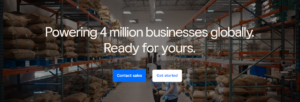
The Square restaurant POS system implements numerous features specifically designed to cater to the restaurant industry, with a transparent pricing model, multi location management, reporting, and more.
It’s tool add-on system enables restaurant owners to pay for only what they need and cut costs in other areas. While the system is operational from any mobile device, the Square EPOS system also has a range of bespoke, optional hardware available.
The Square EPOS system is capable of processing customer payments in person, via mobile, or online, while their custom hardware requires little to no set up to get working.
Better yet, the system is built to easily customise menus, speed up the check out process, provide in-depth sales and product reports, and consolidate customer data into automated customer profiles.
Ease of Use
Navigating the Square user interface is intuitive from beginning to end and set up is painless, catering to operations of all sizes.
Customer Experience Management
Square allows restaurant owners to open direct lines of communication with customers for resolving any feedback, sending coupons, and delivering tailored service accordingly.
Reporting and Analytics
The interface lays all the groundwork for informed decision making by providing detailed reporting on best sellers, average customer spend, employee performance, and stock.
Compatibility
The Square dashboard is fully compatible with a wide range of devices, but your chosen point of sale device may limit the features you have access to.
Pricing
The Square POS platform begins as free-to-use, but charges when you begin taking payments, with 1.75% processing rate on chip and PIN or contactless payments, 2.5% for virtual terminal and invoices, and its hardware range beginning at £19, not including VAT.
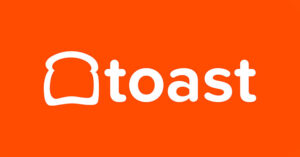
Toast is one of the most popular EPOS in the restaurant business for a reason.
It offers all-encompassing solutions for order and inventory management, menu management, payments, and more.
It provides seamless payment processing, menu customisation and profitability tools, CRM functionality, and thorough analytical reporting on performance and operations.
Ease of Use
Toast is arguably most well known for its excellent user interface. While the initial setup may contain a learning curve, everyday usage is quick and easy.
Customer Experience Management
The package contains all the features you’d expect for tableside payments and quick, bother-free feedback collection from your guests.
Reporting and Analytics
Toast provides key data points across all channels in real time, cutting out waiting times and directly emailing daily results to your inbox every night.
Compatibility
While Toast integrates well with a variety of hardware and software, it’s worth noting that the platform is Android inclusive and doesn’t work on iOS devices.
Pricing
The Starter package goes for £50, while the Essentials package, designed for restaurant owners looking to scale their business, is £150.
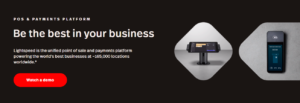
Lightspeed’s features focus on saving time and automation. It offers personalised user support with various multilocation tools and integrations to get you up and running quickly and efficiently.
It offers all the features needed to manage your teams, inventories, and suppliers from one location.
It’s specifically designed to increase visibility in key areas for multilocation operations and offers plenty of customisation options to help you get your ideal experience and functionality.
Ease of Use
Its user interface is simple and intuitive and set up is no challenge, though getting to grips with its various features will take some time.
Customer Experience Management
A key feature here is Lightspeed’s ability to offer customers the same benefits online that they would when visiting your restaurant.
Reporting and Analytics
Its detailed reports give you everything you need to know about staff performance, popular items, and more via its interactive reporting dashboard.
Compatibility
The Lightspeed POS system is compatible with a range of devices, as well as both the Windows and Mac operating systems.
Pricing
Users can expect to pay anywhere between £50 and £300+ for the service, depending on their chosen package.
What To Look For in a EPOS System
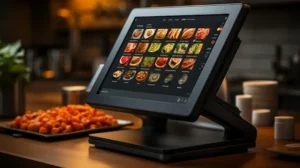
When you sign up with a restaurant EPOS, you’re entrusting a huge part of your operations and performance onto software. In other words, it’s no small decision.
In fact, it’s something like choosing a business partner. As with any kind of relationship, there are a couple of key green flags you should be looking out for before making a choice.
Ease of Use
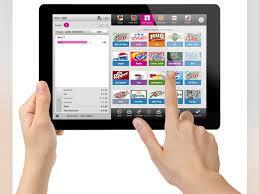
You want to lower the learning curve for you and your staff as much as possible. Something as simple as a receipt printer should never be a headache.
Restaurant POS should have an intuitive, logically laid out user interface. You’ll need simple functionality for tipping and splitting bills, modifying menus, loyalty programs, and a strong customer support team.
Reliable, advanced features will minimise errors and stress, lower training time, and ensure quicker service across the board.
Customer Experience Management
From online ordering to the self service kiosk, an ideal cloud based POS software is designed to improve the customer experience from beginning to end.
Look out for products that personalise the customer’s service, track customer feedback, and organise customer data clearly, allowing you to develop targeted insights about their behaviour.
These can be used to market more directly to existing customers or enhance your customer loyalty programs.
Reporting and Analytics
Data management and analysis is one of the key bedrocks to improving any business’ performance. Hospitality is no different.
Your POS system should tell you about sales trends, item popularity, customer preferences, and more.
Whether it’s a chain franchise or independent restaurant, collecting and analysing data is how you judge the performance and operations of your business.
That means your POS terminals are a centralised location for data-based decision making, boosting revenue and efficiency, managing expenses, and viewing sales reports.
Stock Control
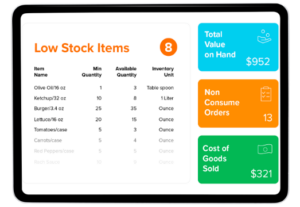
Monitoring stock levels is a key touchstone for a good restaurant EPOS.
With the right features at hand, the restaurant’s point of sale system becomes the best way to get ahead of stocking issues via automated ordering or more accurately track the cost of your dishes.
Compatibility
You’ll need to understand early on exactly what you’ll need in terms of tablets, printers, payment devices, and the like.
The idea is to avoid any surprises that could slow down service in the future and ideally to opt for an EPOS system that easily integrates with your existing hardware.
The same consideration should be made for integration with other essential technologies, such as your chosen accounting software.
Pricing
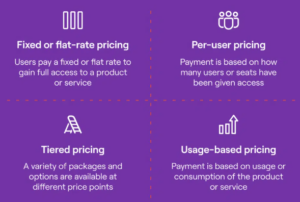
The cost of restaurant EPOS systems can vary significantly, especially when considering both hardware and software, as well as the potential costs involved in integration.
Different softwares may be based on either monthly or yearly subscriptions. They may be tailored to the size of your restaurant or multi location restaurants.
Some provide various options when it comes to contracts, while others may lock you into uncomfortable terms or feature a wealth of hidden costs and transaction fees.
Conclusion
The best restaurant POS systems in 2024 are those that most seamlessly combine advanced tools with user-friendly interfaces.
They provide restaurant owners, managers, and staff with what they need to improve the quality and efficiency of their inventory management, customer engagement, payment, online orders, and more.
A robust EPOS system is one whose sales systems work with minimal input or set up, allow for both payments via portable card machines, mobile payments, or integration with any accounting software.
Tools that allow you to customise your floor plan, manage bookings, tailor your menu, or receive analytical sales reports are extremely valuable as well.
Once again, the ideal point of sale system for you is dependent on your needs and the nature of your business.
Contact NFS Hospitality for helping picking the best platform for your needs.
